Quality of the Environment in Japan 1995
6. Measures for Controlling Other Substances Contributing to Air Pollution
(1) Measures for asbestos
Although asbestos has been used in various products because of its excellent heat resistance, this material can seriously damage human health, including cancer.
By the revision made to the Air Pollution Control Law in 1989, asbestos was classified as specified dust, and facilities that manufacture products containing asbestos were classified as a facility that generates specified dust. Various restrictions are applied to these facilities such as notification of installing or building facilities that generate speci-fied dust; orders to change plans ; obligation to meet the restriction standard set for specified dust; orders to make improvements; and measurements of the levels of specified dust. The Environment Agency conducts investigations on the status of development and propagation of alternative products for asbestos.
(2) Measures for the control of hazardous substances
The Air Pollution Control Law specifies the following, besides nitrogen oxides, as "hazardous substances" that are generated in facil-ities emitting soot and dust: 1) cadmium and its compounds ; 2) chlo-rine and hydrogen chloride ; 3) fluorine, hydrogen fluoride, and silicon fluoride; and 4) lead and its compounds. Emission standards for these hazardous substances listed above are set for specified types of facilities that generate soot and smoke, depending on the substance. This is because the generation of hazardous substances is related to certain material. For other particulate matter that is caused by other means at facilities that generate soot and smoke, restrictions applicable to "soot and dust" are applied.
(3) Measures for controlling nonrestricted substances
In order to control air pollution before its occurrence, investiga-tions have been conducted for substances that are not currently restricted but are considered potentially hazardous to study their levels of emission, impact on the environment, etc.
Concerning air pollution caused by trichloroethylene and tetrach-loroethylene, "Working Group of Measures for Chloriscated Organic Compounds" was held to discuss their impact to human health as well as emission control methods. A report from the studies was submitted in March 1993. Based on the report, "Ambient Air Quality Guideline" (tentative values), indexes for the levels of emission that are desirable to be maintained in order to protect human health, were established in April, 1993. The index for trichloroethylene is specified to be less than or equal to the annual mean of 250 micrograms/m3, and as for tetra-chroloethylene, 230 micrograms/m3. The "Tentative Guideline for Countermeasures against Emission into the Air of Trichlorethylene and Tetrachloroethylene" was also established and also actual conditions of emission were investigated in cooperation with governors of prefectures and mayors of administrative ordinance-designated cities.
Studies on measures against other various and diverse substances that are contributing to air pollution were conducted.
(4) Propagation and education activities
The role the people residing in the community play to preserve the local environment is becoming significantly important. A program called the "National Program of Continuous Star Observations (Star Watching Network)" has been enforced since 1988. The objective of this program is to increase the opportunities in which people can deepen their understanding toward the importance of the preservation of clean air, by letting them observe their natural surroundings in a simple way. In summer of 1994, 9,948 people from 331 organizations nationwide (from 47 prefectures and metropolis, nine administrative ordinance-designated cities, and 408 cities, wards, towns, and villages) participated in this star watching program.
Another program that was carried out was the "Trees' Air Purifying Capability Check," which has been organized for students of junior high and high schools since 1989. The objective of this educational activity is to promote people's awareness toward environmental preser-vation by raising people's understanding about a tree's capability to purify the air. In 1993, approximately 6,000 students from approximate-ly 500 schools participated in the program.
Section3. Improvement of the Monitoring System
Constant monitoring of the status of air pollution is vital to understand the achievement progress of environment standards, and to establish control measures against air pollution. It is also the base of the administration concerning atmospheric conservation.
1. National Atmospheric Monitoring Network
(1) National Atmospheric Monitoring Stations
In order to comprehend the state of air pollution on a nationwide scale, and to obtain basic data necessary to promote measures for atmospheric preservation, national air pollution monitoring stations, national environmental atmospheric monitoring stations, and national roadside air pollution monitoring stations are placed throughout the country. Figure 7-3-1 shows the nationwide arrangement of the national atmospheric monitoring network which consists of the national atmo-spheric monitoring stations and national acid deposition monitoring stations.
The national air pollution monitoring stations are placed in 15 areas nationwide in order to understand the status of air pollution in major areas. Eight national environmental atmospheric monitoring stations are placed in major plains, with the objective of understanding levels of pollution in areas that have not yet been polluted. Each monitoring station has various measuring equipment to constantly monitor the level of pollutants such as sulfur dioxide, nitrogen oxides, suspended particulate matter, etc. Analysis of metal composition of suspended particulate matter and suspended fragmentary dust is also conducted. Some of the national environmental atmospheric monitoring stations perform measurements of hydrogen sulfide, ozone, mercury, etc.
To monitor the levels of road-side air pollution, three national automobile exhaust monitoring stations are placed within the Tokyo Metropolis, one in Maebashi City, Gunma Prefecture.
Fig. 7-3-1 Location of National Atmospheric Environment Monitoring Stations
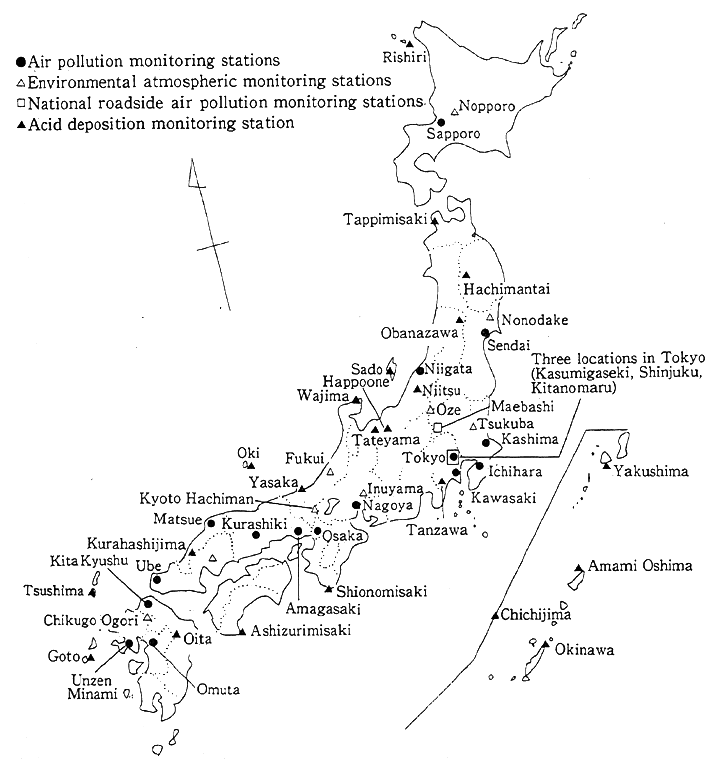
(2) National Acid Deposition Monitoring Stations
In an effort to enhance the acid deposition monitoring system, acid deposition measurement equipment were installed in 23 atmo-spheric monitoring stations in 1987. Since 1989, acid deposition monitor-ing stations have been built throughout the country in order to perform analysis of pH levels and composition of precipitation. Three additional stations started their services in 1994.
2. Local Air Pollution Monitoring System
In rural areas, the monitoring of pollution levels is conducted under the supervision of the governor of each prefecture or metropolis, or mayor of each administrative ordinance-designated city, in conform-ity with the Air Pollution Control Law. The monitoring of pollution levels is conducted by other local public entities as well. The installation of telemetric devices that constantly monitor levels of sulfur dioxide and the amount of fuel used, etc. at the sources generating the air pollutant, and transmit the data to the Central Monitoring Center, has been in progress. Governmental support to improve the measurement equipment necessary for the monitoring conducted by prefectures, metropolis, or administrative ordinance-designated cities, has been provided. The Government also encourages systematic and intensified improvement of monitoring system to achieve efficiency, and to raise the standard of measuring technology. Improvement of the facilities of Local Institute for Environmental Pollution Control has been promoted by the Government as well in order to comprehend the actual state of hazardous chemical substances.
Section4. Present State of Traffic Pollution and Counter-measures
1. Comprehensive Promotion
The traffic system in Japan has progressed extremely rapidly during the periods of economic revival after the World War II followed by high-level economic growth. The high-level and diverse progress of the traffic system achieved during these periods has brought the society numerous advantages. On the other hand, however, it has produced problems of traffic pollution in areas surrounding large traffic facilities. In large cities, the amount of traffic is only increasing in proportion to the progress of the service-oriented economic society, increased number of office buildings, etc., on top of the concentrated population and industries. Many types of urban facilities are intertangled in large cities, without sufficient measures from the standpoint of preservation of the traffic environment being taken, such as coordination between traffic facilities and the use of land surrounding them, and control of traffic volume. Including these problems that originate from the structure of a large city, the resolution of traffic pollution is getting increasingly difficult.
Exhaust gas, noise, and vibration are all generated by automo-biles, contributing to the creation of road traffic pollution. Enforcement of further measures that are explained later in this section should be promoted systematically and strictly in order to control exhaust gas such as nitrogen oxides, noise, and vibration.
For aircraft noise, the conventional measures for controlling sources of noise generation and the improvement of the structure of airports should be promoted intensively, in order to achieve the environ-mental quality standards, as air transportation is expected to expand. For areas where the environmental quality standards can not be met by only enforcing these measures, measures to control the problems such as implementing soundproofing works for residents, should be taken for the time being. The usage of land in areas suffering from extreme noise should be switched from residential use to whatever is not affected by noise, and any plans to develop new residential areas within the areas subjected to noise should be controlled. It is essential to promote measures for proper land usage within the affected areas systemat-ically.
To control noise and vibration caused by Shinkansen (bullet trains), comprehensive measures should be taken to meet the environ-mental standards. Measures to control the sources generating noise and vibration should be promoted intensively, as well as other measures such as controlling existing problems and appropriate land usage in the affected areas.
As for the noise problem, the achievement status of the environ-mental quality standards by any of the Tokaido, Sanyo, Tohoku, or Joetsu Shinkansen systems is not favorable. To achieve the environmen-tal qualiey standards as soon as possible, the following measures are to be promoted:
1) control of the noise sources as principal measures
2) soundproofing works for residences in areas subjected to noise levels exceeding the environmental quality standard
3) development and application of noise reduction technologies
4) appropriate land usage in the areas subjected to noise (control of development plans for residential use, promotion of building public facilities whose functions will not be affected by noise, etc.) Currently, no restrictions are applied to levels of nitrogen oxides, sulfur oxides, etc. that are emitted from ships. The International Maritime Organization (IMO) has been studying on specific control measures to be taken so that the restrictions can be enforced as early as possible after 1995. In Japan, ships are expected to contribute to future air pollution in areas with major ports. Studies on the current status of emissions from ships, the latest emission reduction technologies, and so on have been conducted to establish methods to reduce emissions from ships, in conformity with international movements.
2. Measures for Road Traffic Pollution
(1) Current conditions of road traffic pollution
In Japan, the concentration of population and industries in urban areas and heavy motorization have taken place during the formation process of the high-level economic society. The number of automobiles owned as of the end of 1971 was 21,220,000 units, and was 66,280,000 units as of the end of 1993, which is an increase by approximately 310% (Figure 7-4-1). And the advancement of motorization is continuing. Problems originating from road traffic such as air pollution, noise, and vibration are present especially in major cities and areas along major roads throughout the country.
Measurement results from roadside air pollution monitoring stations are shown in Part II, Chapter 7, Section 1. Many monitoring stations in the major city areas record levels of nitrogen dioxide and suspended particulate matter that exceed the levels of the environmen-tal quality standard, and current air pollution status is not favorable (Table 7-4-1).
Figure 5-1-15 in Part I shows the results of automobile noise measurements conducted in 1993 by prefectures and municipalities. The measurements were taken at 4,605 measurement points (limited to measurements taken in the designated areas by the Noise Regulation Law) at which the noise level is considered typical within the area, or noise related problems occur frequently. The levels measured at 3,988 points failed to attain the environmental quality standards pertaining to noise, 1,460 points recorded levels exceeding the limit specified by Sub-section 1, Section 17 of the Noise Regulation Law.
Figure 5-1-16 in Part I shows the results of the measurements taken at 1,600 points at which measurements have been conducted for five consecutive years since 1989. Although the results cannot be simply compared since the date or the time periods measured were different from year to year, the number of points where the environmental quality standard was not attained was 1,402 in 1993, still remaining at a high level.
Fig. 7-4-1 Changes in Number of Autoniobiles in Operation
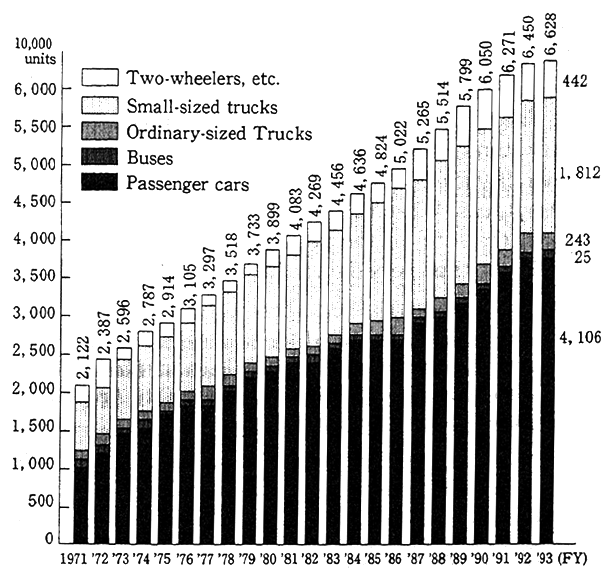
Notes :1. Prepared based on Yearly Statistical Report of Automobile Transportation by Ministry of Transpor.
2. Passenger cars include mini-sized cars.
3. Small-sized trucks include mini-sized trucks.
Table 7-4-1 Achievement Status of Environment Quality Standards concerning Nitrogen Dioxide at Roadside Air Pollution Monitoring Stations in Major Cities (areas specified in the Automobile Nox Law)

Note : Data by the Environment Agency
Figure 7-4-2 shows the comparison of the attained status of the environmental quality standard between the major city areas (23 wards in Tokyo and 12 administrative ordinance-designated cities) and the other areas. The ratio of the measurement points at which the environ mental quality standard was not attained in all four time periods was 74.0 % in the major city areas, which is significantly high as compared to 52.1 % of the other areas. When the measurement points were classified by types of roads, the ratio of the points at which the standard was not attained in all four time periods was highest in the urban expressways,
Fig. 7-4-2 Achievement Status of Environmental Quality Standards and the Exceeding Ratio of Request Limits concerning Automobile Traffic Noise in Major City Areas and Other Areas (fiscal year 1993)

Fig. 7-4-3 Achievement Status of Environmental Quality Standards and the Exceeding Ratio of Request Limits concerning Automobile Traffic Noise by Type of Roads (fiscal year 1993) second highest in the general national roads, and third in the major local roads (Figure 7-4-3).
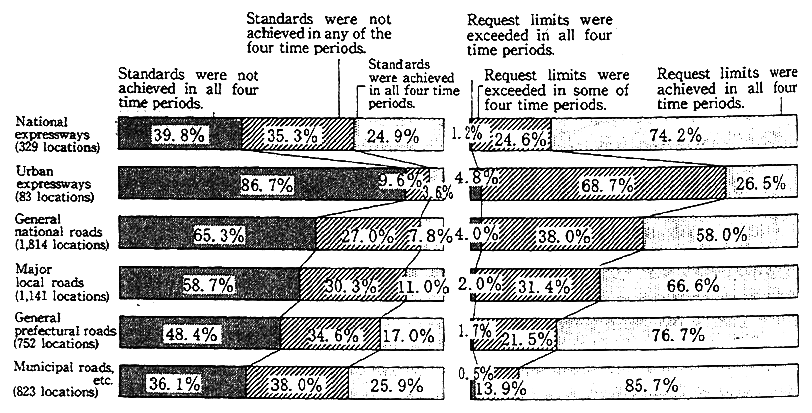
(2) Direction of measures for road traffic pollution
1) Environmental quality standards and legislation
Comprehensive measures for controlling road traffic pollution are being taken to achieve the environmental quality standards set for air pollution and noise in accordance with the Basic Environment Law.
The Air Pollution Control Law and the Noise Regulation Law specify that in order to reduce exhaust emissions and noise by improv-ing the mechanism of automobiles, the Director General of the Environ-ment Agency is to set the allowable levels of automobile emissions and noise. The laws also specify that when the Minister of Transport is to determine the necessary items for the safety standards for road vehi-cles, in conformity with the Road Vehicles Act, consideration must be taken so that the allowable levels set by the Director General of the Environment Agency are ensured. The laws indicate that, when the levels of emission or noise exceed the specified limits, governors of prefectures or metropolis are to request the Prefectural Public Safety Commissions to take the measures specified by the Road Traffic Law. The laws also indicate that the governors can suggest their opinions, when necessary, to the person in charge of maintenance of the road, concerning the items that are pertinent to the improvement of the partial structure of the road in question, and the reduction of the exhaust emission and noise levels (Table 7-4-2).
Table 7-4-2 Numbers of Requests or Opinions Made by Governor of Prefectures concerning Automobile Noise According to Noise Regulation Law

Note : Data by the Environment Agency
The Law Concerning Special Measures for Total Emission Reduction of Nitrogen Oxides from Automobiles in Specified Areas (referred to as 'Automobile NOx Law' hereafter) is aiming at protecting people's health by maintaining the environmental quality standard for nitrogen dioxide. The law determines the basic policy for the reduction of total amount of nitrogen oxides emitted from automobiles in speci-fied areas where the condition of air pollution by nitrogen oxides is severe, and also determines the Basic Policy for NOx Reduction and the NOx Emission Reduction Plan. The law also sets the special NOx emission standard for nitrogen oxides emitted from trucks and buses that are mainly used in specified areas. It stipulates measures to be taken such as establishing guidelines for business owners for promoting efficient use of automobiles.
The Vibration Regulation Law specifies that when the governor of a prefecture recognizes that vibration levels measured on a particular road exceeds the allowable limit, resulting in marring the living environ-ment of the area, the governor is to request a person in charge of the maintenance of the road to take measures to improve the portion of the road causing the problem. The law also specifies that the governor is to request the Prefectural Public Safety Commission to take measures that are specified in the Road Traffic Law.
There were two cases where such requests were made to the person in charge of the maintenance of the road in recent years; one case in 1991, and another in 1993.
2) The system of the measures
The following is the basic concept for the time being as to how the measures for road traffic pollution are being promoted.
i. Measures for exhaust emission such as nitrogen oxides in major cities, etc.
Automobile exhaust gases are one of the reasons why air pollu-tion caused by nitrogen oxides can not be improved in major cities. Despite the effects of emission controls that have been enforced for each vehicle, the amount of exhaust emission has not been reduced notably because of the largely increased volume of traffic as well as the ratio of diesel-powered vehicles among trucks. The following measures are being promoted comprehensively:
1) As measures for controls against each vehicle, automobile emis-sion controls are to be further tightened, as explained later in this section, and also the swift switch to low pollution vehicles, such as vehicles that meet the latest emission standard, is to be encouraged.
As for low-emission vehicles, CNG (Compressed Natural Gas) vehicles and hybrid vehicles have been put in practical use as well as electric and methanol vehicles. Research and development of these vehicles are to be actively promoted in order to improve their perfor-mance so that they can be used in wider areas. At the same time, introduction of these vehicles in many different fields of application is to be encouraged so that they can be adopted on a mass-quantity scale.
2) Various measures to improve traffic volume are to be promoted comprehensively and systematically. These measures include: promo-tion of switching from small private-use trucks to commercial-use trucks with more loading capacity; optimization of delivery routes used mainly by private-use trucks; reduction of traffic volume of trucks by improving transportation efficiency using larger trucks and the cooperative delivery system ; reduction of traffic volume of private-use passenger cars by improving public transportation systems ; improve-ment of loop roads in consideration of environmental preservation; improvement of traffic monitoring systems; and imptovement of the structure of intersections to decentralize the traffic flow and to make it flow smoother.
3) In the areas specified by the Automobile NOx Law, measures are to be promoted in conformity with the NOx Emission Reduction Plan as this is the concrete plan for the reduction of nitrogen oxides emitted from automobiles in the specified areas. Restrictions on the use of designated vehicles that do not meet the special NOx emission standard set for trucks and buses mainly used in the specified areas, are to be enforced smoothly.
ii. Measures for noise and vibration caused by road traffic
An automobile generates various types of noise from its engine, air intake and exhaust system, drive shaft, tires, etc. However, noise caused by road traffic means a more complex one, combination of such noise generated from an automobile itself and various other factors such as the traffic volume, type of vehicles running, speed, structure of the road, type of land usage in the area, etc. Vibration caused by road traffic is also created by many factors such as weight of vehicles, running conditions, flatness of the road, structure of the paving, condi-tion of the roadbed, etc. To radically resolve the noise and vibration problems, various measures are being comprehensively promoted. These measures include improvement of structure of automobiles, as a measure to control sources of noise and vibration; improvement of traffic flows ; improvement of road structure ; improvement of road-side conditions ; and so forth (Figure 7-4-4).
Fig. 7-4-4 System of Road Traffic Noise Countermeasures
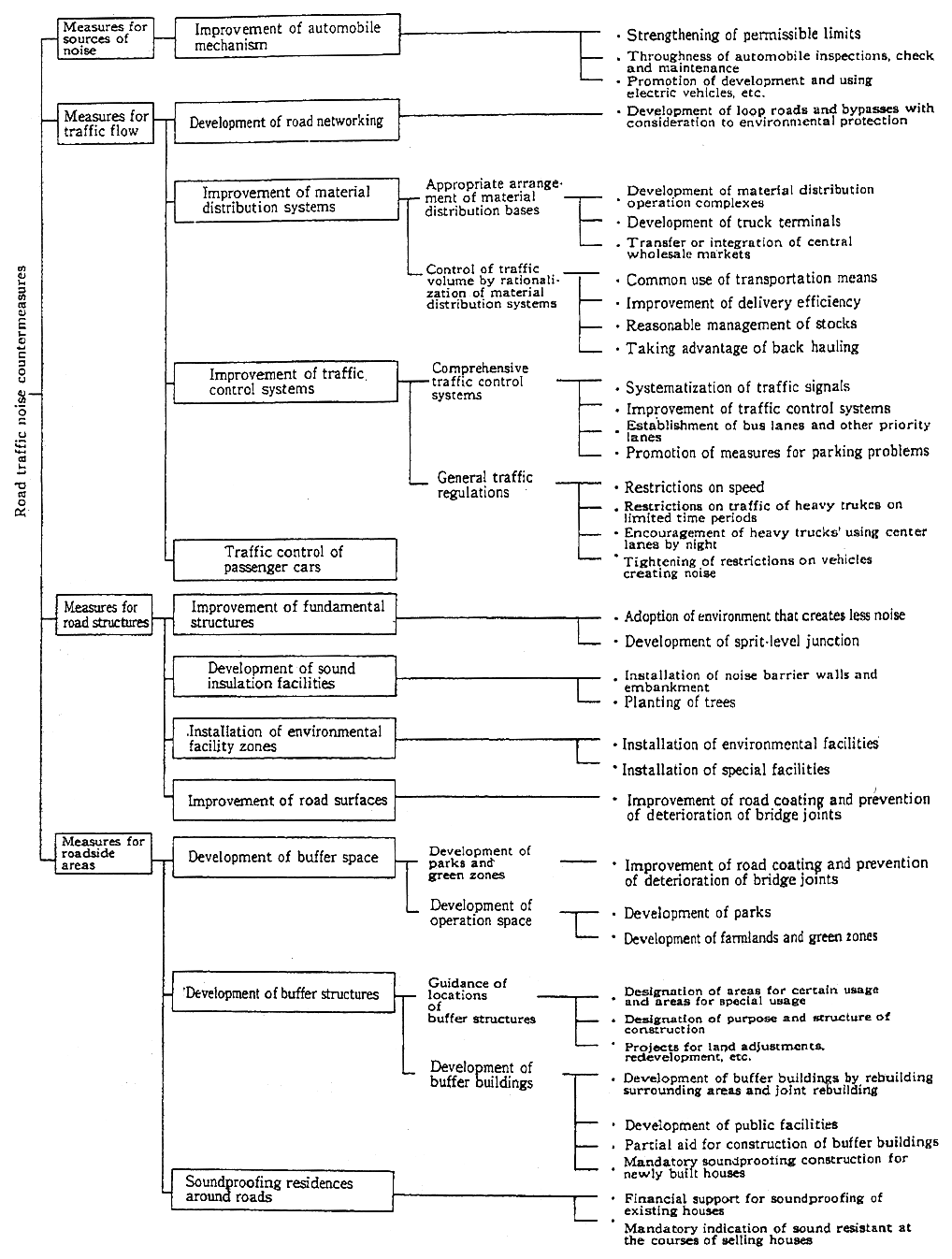
The following are the concrete measures that are being promoted for the noise problem.
1) In each area where noise problems are caused, measures to improve the structure of roads are being enforced. At the same time, support for residential soundproofing work have been provided, and the use of bypass roads by large vehicles is being encouraged.
2) As basic measures with consideration of conditions specific to each area, various measures are being promoted in major cities. These include : controls of total traffic volume by improving efficiency of physical distribution systems as well as by controlling the number of vehicles used privately; controls of large vehicles driving into the center of the city by placing distribution facilities in appropriate loca-tions; appropriate use of the road-side land and controls of passing-by traffic driving through the center of the city by improving bypass roads with consideration to the preservation of the road-side environment.
3) Education on proper maintenance of vehicles and driving tech-niques, advancement of vehicles with low noise, and development of various noise reduction technologies, are being promoted in order to tighten the controls for each vehicle.
iii. Improvement of the measure promoting system
In promoting measures to control road traffic pollution, the Government should promote the measures that it is responsible for, in close cooperation with the concerned ministries and agencies, and support the measures to be taken by local public entities at the same time. Since road traffic pollution is a problem that is closely connected with the condition of the area that the pollution is taking place, each prefecture or metropolis should be actively involved in determining effective measures to solve the problem with consideration of the actual condition of the area. Branch offices of governmental ministries and agencies should, whenever necessary, be involved in local councils where determination of measures is made.
In accordance with the direction of activities explained above, the Environment Agency indicated how to determine a comprehensive plan to control noise caused by road traffic to prefectures and metropolis, to support local activities according to the actual condition of the area. The agency is also conducting noise-related investigations in some model areas. The agency is to actively promote measures to carry out the Pollution Control Programs as well.
Campaigns to promote the switch to vehicles satisfying the latest emission standard and to promote the prevention of air pollution are enforced, using the fund established within the Pollution-Related Health Damage Compensation and Prevention Association by the Pollution-Related Health Damage Compensation and Prevention Law (referred to as "Fund Established by the Pollution-Related Health Damage Law hereafter).
(3) Improvement of automobile mechanisms
1) Measures for exhaust emission
Restrictions on nitrogen oxides emitted from motor vehicles were initiated in 1973 for gasoline or LPG-powered vehicles, and 1974 for diesel-powered vehicles. In 1978, new restrictions ('78 Restrictions) for vehicles using gasoline or LPG were enforced. The new restrictions adopted the target level of nitrogen oxides suggested by the Central Council for Environmental Pollution Control in their intermediate report in 1972, the average emission level of 0.25g/km, which is less than one tenth of the level before the original restrictions were enforced.
Restrictions on automobiles using fuel other than gasoline or LPG (i.e., trucks, buses, etc.) were first enforced during the years of 1973 and 1974. The restrictions were tightened in 1975 and 1977, and were enfor-ced in 1979 as the '79 -'83 Restrictions, adopting the two-phase target levels suggested by the Central Council for Environment Pollution Control in their report in 1977.
Restrictions on the black smoke emitted from diesel-powered vehicles have been enforced since 1972 against new vehicles, and since 1975 for used vehicles (pollution ratio 50%).
Although the restrictions on exhaust emissions have been tight-ened successively, further reduction of nitrogen oxides and particulate matter is required in large cities with heavy traffic since the number of vehicles running in those areas is only increasing. In 1985, the Central Council for Environmental Pollution Control was inquired about the measures for automobile emission reduction in the future. Based on the intermediate report on this matter submitted in 1986, the restrictions were tightened by 1990, and the level of nitrogen oxides emitted from heavy-duty diesel trucks was reduced by 15%, the emission from light-duty trucks was reduced to the same level as passenger cars.
Restrictions on nitrogen oxides emitted from diesel-powered passenger cars were also tightened in 1990 and 1992, and the emission level was reduced by 30%.
In December 1989, the final report was submitted, of which the details are as below. The restrictions are to be enforced with the target levels in two phases, the short-term (within five years) targets and the long-term (within ten years) targets (Tables 7-2-1 and 7-4-3).
i. Drastic reduction of nitrogen oxides
1) Levels of nitrogen oxides emitted from diesel-powered vehi-cles to be reduced by 30 -60%.
2) Levels of nitrogen oxides emitted from direct injection type vehicles to be reduced to the levels of divided combustion chamber type vehicles.
3) Setting of the long-term targets; emission levels of diesel-powered vehicles to be the same levels as gasoline-powered vehicles.
ii. Fundamental review of measures for particulate matter
1) Restrictions on particulate matter emitted from diesel-powered vehicles to be established, and the emission levels to be reduced by 60% or more.
2) Levels of black smoke emitted from diesel-powered vehicles to be reduced by 50%.
iii. Sulfur content of diesel fuel to be reduced by 90%.
iv. Review of measurement modes
In accordance with this report, arrangements were made in March 1991, to enforce the tightened restrictions to achieve the short-term targets. As for long-term targets, the Investigation Committee for Motor Vehicle Exhaust Emission Control Technology has been held since October 1990 to conduct technical evaluations continuously in order to achieve the long-term targets as soon as possible. According to the report submitted in June 1992 by the committee, the tightening of restrictions for gasoline-fueled medium-duty vehicles is to be enforced in 1994, and in 1995 for gasoline-fueled heavy-duty vehicles. The reports submitted in August 1993 and October 1994 by the committee evaluated that the long-term targets for diesel-powered vehicles, excluding heavy-duty trucks and buses, will be attained in 1997 or 1998. Since the long-term targets were set aiming to be attained within ten years from the time when the initial inquiry was made, efforts should be made so that targets set for other types of vehicles can be achieved as early as possible, by carrying out continuous technical evaluations while encour-aging auto manufacturers for necessary technological development.
Table 7-4-3 Progression of Vehicle Exhaust Controls
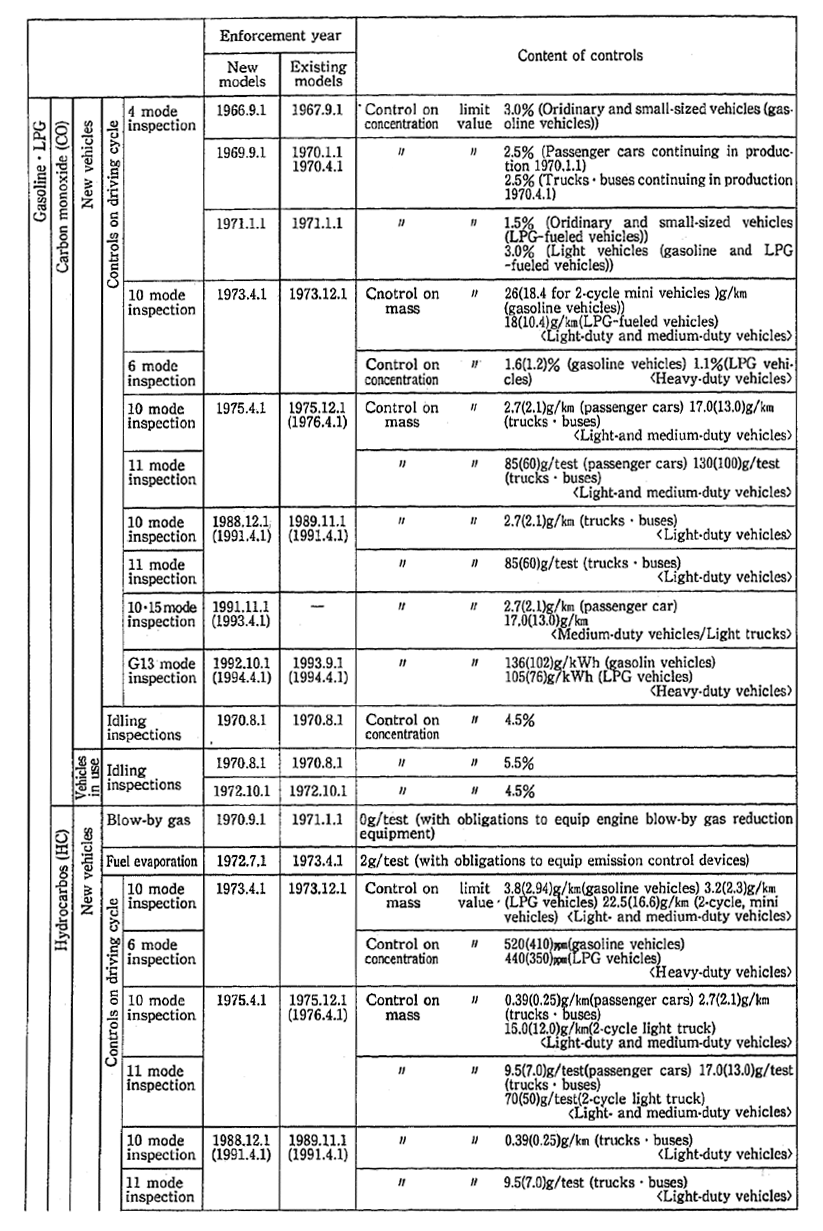
(Table 7-4-3 continued)
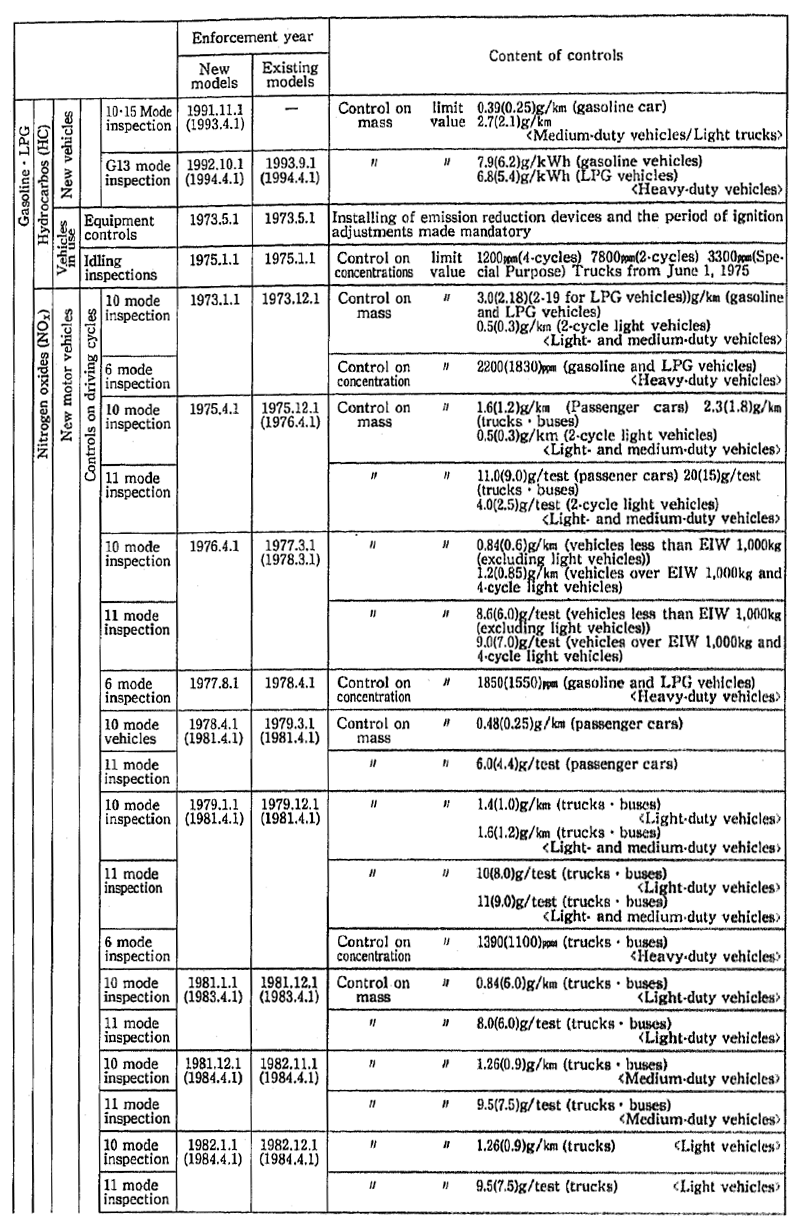
(Table 7-4-3 continued)
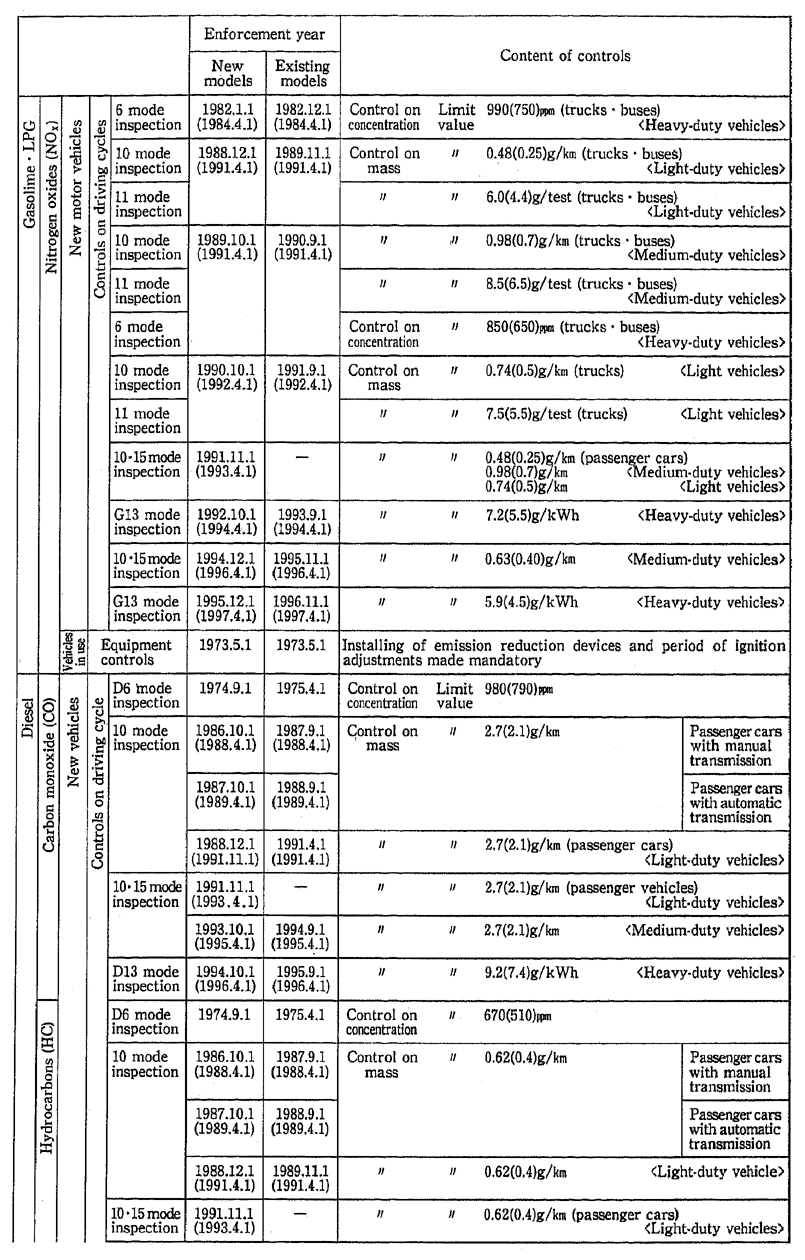
(Table 7-4-3 continued)
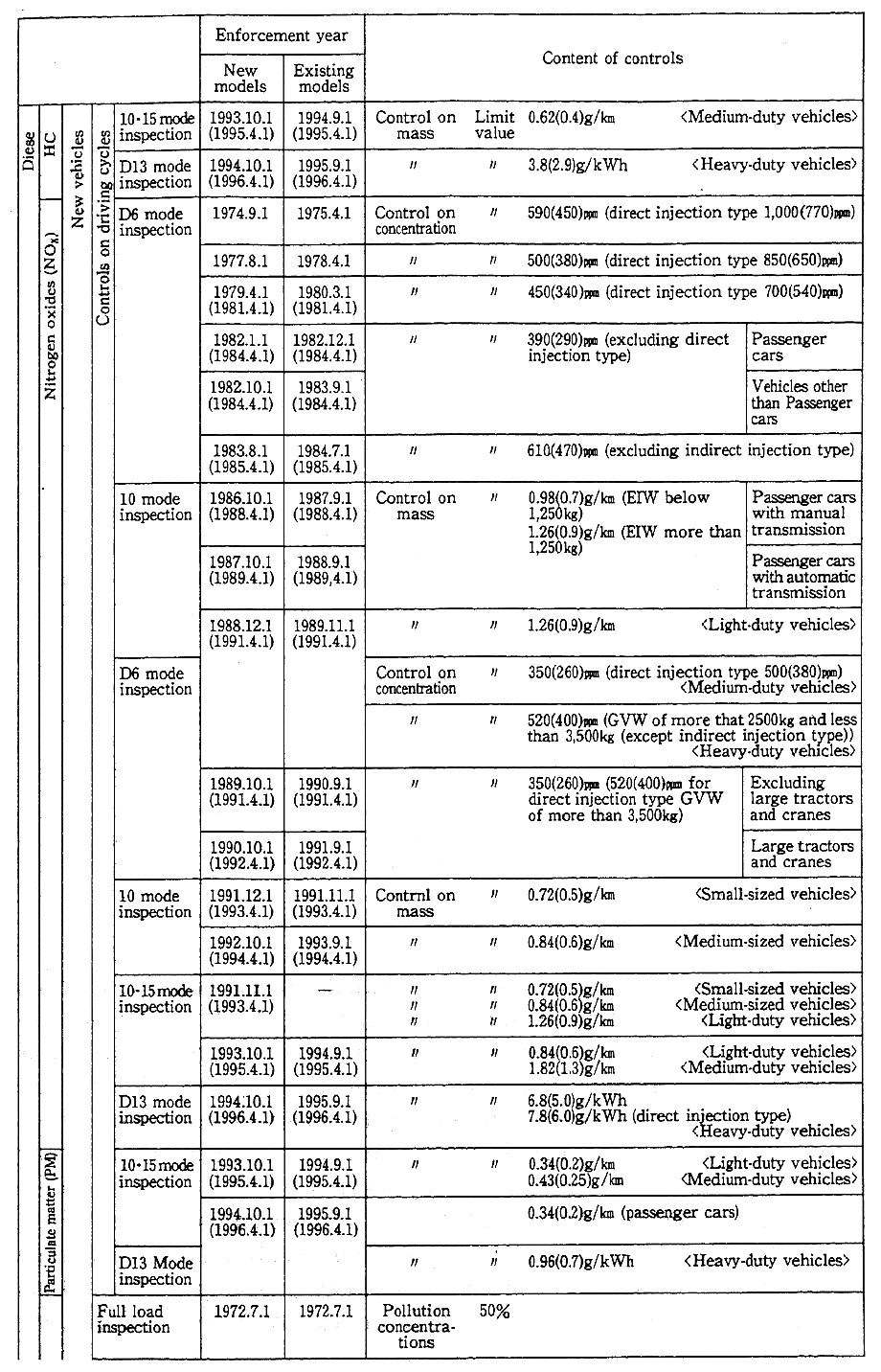
(Table 7-4-3 continued)
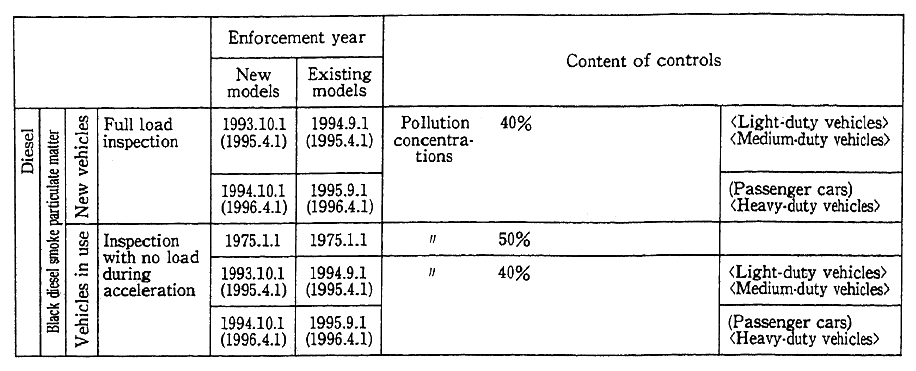
Notes : 1. The figures in parentheses for the limit values are average values.
2. [Light-duty vehicles] are ordinary and small-sized vehicles with a gross vehicle weight of less than 1,700 kg.
[Medium-duty vehicles] are ordinary and small-sized vehicles with a gross vehicle weight of more than 1,700kg and less than 2,500kg.
[Heavy-duty vehicles] are ordinary and small-sized vehicles with a gross vehicle weight of more than 2,500kg (excluding passenger cars)
[Light-and medium-duty vehicles] are light-and medium-duty, light auto-mobiles, and passenger cars with a gross vehicle weight of over 2,500kg.
[Small-sized vehicles] are diesel passenger vehicles with equivalent iner-tia weight of less that 1,250kg.
[Medium-duty vehicles] are diesel passenger cars with an equivalent inertia weight of more than 1,250kg.
EIW is equivalent inertia weight.
GVW is total vehicle weight.
3. The figures in parentheses in the column for the enforcement year are the time of application of regulations on imported vehicles.
4. For exhaust emission controls in 1975, for HG regulations for light vehicles with 2-cycle engines, the period of application was extended to September 30, 1977. (During this time, the provisional control values were 5.6(4.5)g/km for 10 mode inspections and 33(25)g/test for 11 mode inspec-tions.)
Investigations are under way to determine the necessity of enforc-ing emission controls against motorcycles and special-purpose vehicles, which are currently not applicable to any exhaust emission restrictions.
In an effort to promote the reduction in sulfur content of diesel fuel, reduced income tax, corporate tax, and property tax have been applied to specified facilities purchased by owners of oil refining businesses.
As part of the measures to improve the state of air pollution as early as possible, switching from old models of diesel trucks or buses, which contribute to pollution significantly, to trucks or buses that meet the latest emission standard, is being encouraged. Some special tax measures have been taken since 1990 to help promote the switch, such as reduced automobile tax (only until 1993), reduced automobile acquisi-tion tax, and special redemption system. Loans to be applied to the purchase of vehicles have been provided with low-interest through the Japan Development Bank, the Smaller Business Finance Corporation, etc.
As free trading further continues in its course, the Provisional Measures Law on the Importation of Specific Kinds of Petroleum Refined Products will be abolished as it expires in March of 1996, and the range of corporations to import petroleum products (gasoline, diesel oil, and kerosene) is expected to expand. Currently, preservation of the atmospheric environment is to be realized on the assumption that a certain quality of petroleum products be maintained. Therefore, if the petroleum products of inferior quality are circulated in the market because of the expanded range of importers, it could impact the atmo-spheric environment unfavorably. To prevent this, a legislative bill proposing the amendments of the Air Pollution Control Law was sub-mitted to the 132nd Diet. The bill proposes to make provisions of securing the quality of automobile fuels, the people's efforts to control automobile exhaust emissions, and so on.
2) Measures for noise
Restrictions on automobile noise are enforced to control the sources of the noise, aiming at the reduction of noise levels generated from an automobile by improving the structure of the vehicle.
The restrictions are enforced for three types of noises: the ac-celerated running noise, the loudest noise generated by a vehicle running in urban areas ; the steady running noise, the noise generated when running at a cruising speed; and the proximity stationary noise, the noise levels often used to control noise generated by used vehicles on streets.
Restrictions on noise generated by new vehicles have been tight-ened on several occasions ever since the restrictions on the accelerated running noise were first enforced in 1971. The tightening of the restric-tions after 1979 were enforced in conformity with the target levels of the accelerated running noise which were indicated in the report submitted by the Central Council for Environmental Pollution Control in June 1976. The latest allowable level has been drastically reduced by 6 to 11 dB as compared to the level allowed in 1971.
Restrictions on the proximity stationary noise, which can be measured readily on streets, have been enforced against new and used vehicles since June, 1986, and have proven effective for controls of illegally modified vehicles. Measures such as this have been playing an important role in controlling road traffic noise.
However, despite all tightened restrictions, the achievement ratio of the environmental standard in areas around major roads remains at a low level due to the increased traffic volume, etc., and it is required to bring the noise levels down even further. In June 1991, the Central Council for Environmental Pollution Control was inquired regarding "The Future Policy for Motor Vehicle Noise Reduction." In November 1992, the intermediate report that suggests the target levels of the accelerated running noise to be reduced by 1 -3dB was submitted. Another report was submitted in February 1995, suggesting the levels of the steady running noise to be reduced by 1 -6.1dB, the proximity stationary noise to be reduced by 3 -11dB. These target levels are one of the most strict levels in the world. The Environment Agency is to strive to achieve these levels as early as possible, according to the suggestions made in the report.
(4) Promotion of low-emission vehicles
Various activities are being carried out to promote the use of low-emission vehicles such as: promoting development of technologies to improve their performance; providing support to lower the price; promoting improvement of infrastructure (fuel supply facilities) ; and so on.
Other activities include: development of next generation bat-teries for electric vehicles ; research and development for the practical use of CNG vehicles ; field surveys of low-emission vehicles conducted by private businesses in major cities; trial use of electric vehicles by the personnel of the Environment Agency, and so on. To promote the development of the low-emission vehicles, systematic evaluations of emissions were conducted, and investigations have been carried out since December 1993 in order to establish a guideline for the target exhaust emission for these vehicles.
Measures to support lowering the price of the low-emission vehicles include: financial aid to local public entities for introducing these vehicles for their pollution monitoring cars; financial aid for introduction of these vehicles using the Fund Established by the Pollution-Related Health Damage Law; financial aid for private bus companies to support their programs to introduce low-emission buses; reduced local taxes such as automobile acquisition tax, etc. ; and spe-cial case of depreciation or tax deductions for the purchase of these vehicles (from April 1994 until March 1996).
In order to improve fuel supply facilities, 37 facilities were im-proved by 1994 in accordance with the "Eco-station 2000 Plan," and regulations concerning the building of fuel supply facilities have been lessened.
The "Low-Emission Vehicle Fair," where all types of low-emission vehicles were exhibited to let the public know more about them, was held in eight areas nationwide including Tokyo Yoyogi Park. Table 7-4-4 shows a list of measures taken to promote and advance low-emission vehicles.
(5) Traffic controls
Establishing and maintaining safe and smooth traffic flow is critical in reducing the levels of air pollution, noise, and vibration caused by road traffic. The following are the measures being taken to prevent road traffic pollution:
1) On major roads, measures such as improvement of traffic control systems, improvement of traffic signal control technologies, and inspec-tion and review of traffic rules, have been taken to reduce the frequency of starts and stops at intersections. Traffic volume and flow are disper-sed and guided appropriately, by enhancing the traffic information collecting and supplying system including the travel time estimate service. These measures are part of the effort to reduce levels of nitrogen oxides, carbon dioxide which is causing global warming, noise, and vibration.
2) Various traffic rules are enforced effectively to help improve the environment, especially in urban areas. Those rules are as follows:
(1) A residential area is classified into various zones according to the nature of each area. Depending on the nature of the designated zone, appropriate traffic rules, such as "Large Vehicles Prohibit-ed," are applied to the zone to ensure a good living environment.
(2) Establishment of bus lanes and priority lanes for other public transportation means has been promoted in order to encourage switching from private cars to public transportation to help reduce the overall traffic volume.
Table 7-4-4 Status of Governmental Measures for Promotion of Low-emission Vehicles
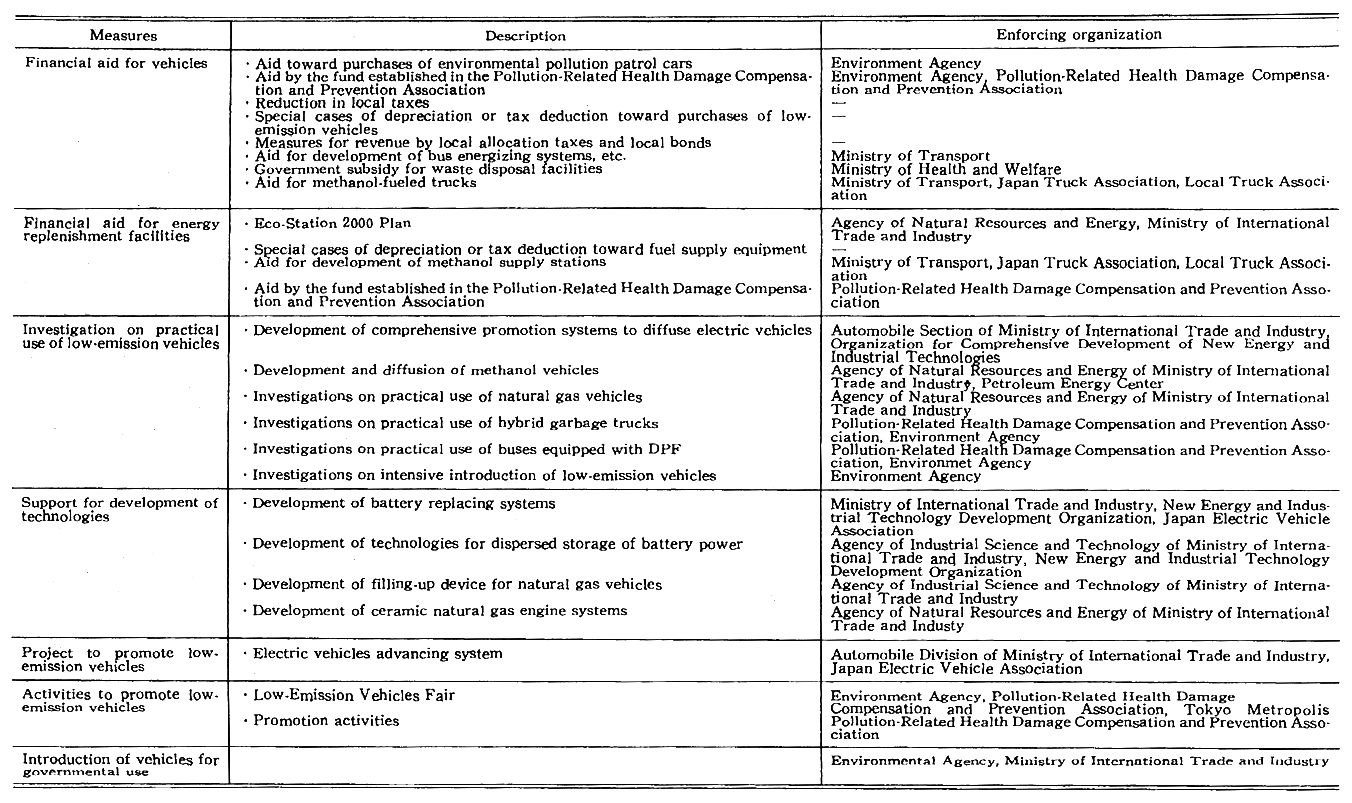
(3) Center lanes are designated for the use by heavy-duty vehicles to help reduce noise and vibration created by them.
3) To eliminate illegal parking, which is hindering smooth traffic flow in urban areas, the illegal parking control system, the parking guiding system, etc. have been improved. Strict controls are enforced using wheel stoppers, etc. for those vehicles parked in a vicious, danger-ous, or aggravating way.
4) The number of complaints reported from residents regarding the noise created by motorcycle gangs has been increasing. In accordance with the revision made to the Road Traffic Law in 1992, controls on defective mufflers have been tightened. There were 5,262 cases of defective mufflers mostly due to members of motorcycle gangs in 1994.
5) Controls on overloading, which is contributing significantly to generation of noise and vibration, have been tightened by seeking the hidden responsibility of the shipper, etc. There were 77,214 cases of overloading incidents in 1994. To prevent noise originating from high-speed running, the high-speed running control system was improved.
(6) Improvement of the road structure and the roadside environment
In order to disperse traffic volume and make traffic flow smooth-ly, road networks such as bypasses and loop roads have been systemat-ically improved. To reduce the burden on the environment, traffic congestion has been relieved by improving intersections, introducing new traffic systems, improving parking and parking guiding systems, etc. Studies have been under way to develop a new physical distribution system utilizing underground space. To prevent pollution, Environmen-tal Impact Assessments are conducted as necessary when improving bypasses, etc.
Measures to improve road structure have been promoted such as improvement of environmental facilities and sound insulating walls, planting trees along roads, introduction of paving that creates less noise, and so on.
As of the end of 1994, a total of approximately 112km of roads on seven routes were designated as roads of which the roadside areas are to be developed, in accordance with the "Law for the Improvement of Areas Along Trunk Roads." The development plans for 65km of roads in 27 areas, including 20 areas along Loop 7, have been determined. To help realize these plans, supportive measures such as bearing the con-struction cost of buffer structures, financial aid for soundproofing constructions, and providing loans without interest for cities, towns, or villages for the purchase of land, have been taken.
For those residences along the national expressways that are suffering severely from noise, financial aid for soundproofing construc-tions has been provided as emergency measures. As of the end of 1994, support was provided to approximately 49,700 residences.
Long-term loans with low interest have been provided by the "Road Development Loan System" established in 1985, for the construc-tion of structures which improve the roadside environment.
Persons in charge of road maintenance collect and provide traffic information as part of their road management operations. They also strive to maintain the roadside environment by enforcing controls and giving instructions to drivers who are violating the vehicle restriction rules. In 1993, controls and instructions were enforced against 7,814 vehicles violating the vehicle restriction rules.
(7) Improvement of efficiency of physical distribution system
To resolve road traffic pollution such as air pollution, noise, and vibration, establishing the efficient physical distribution system and the traffic system that will create less pollution is essential, as well as taking measures against automobiles themselves.
From this point of view, the following measures for improving the efficiency of the physical distribution system are being taken to prevent road traffic pollution.
To improve the efficiency of the physical distribution system on arterial lines, the use of appropriate transportation mode, such as railway or marine transportation, in between mid to long-distance distribution centers, should be encouraged. To promote this, special tax measures and loans through the Japan Development Bank are provided for the improvement of equipment to be used in intermodal transporta-tion. Financial aid is being provided for the improvement of rail freight bases which are essential to reinforce the rail freight capacity. Other measures are being taken to improve efficiency of domestic container ships, ro ro ships, etc. by stimulating the adoption of the "Freight Space Adjustment System", and also to improve the facilities of domestic trade unit road terminals.
In the area of local physical distribution systems, the efficient use of trucks is the key to improve the efficiency. The switch from private-purpose trucks to commercial-purpose trucks, which offer more effi-cient loading space, is being encouraged. For the areas where the use of smaller trucks is more suitable, efforts to raise the efficiency such as optimizing delivery routes, etc. are being made. Also promoted is the improvement of the combined transportation system and the consoli-dated delivery system operated by commercial-purpose trucks.
Various measures are being taken to establish an efficient physi-cal distribution system. These measures include: improvement of roads that have access to major distribution facilities such as airports, ports, etc.; centralization and appropriate placement of distribution centers such as warehouses, truck terminals, etc.; measures to accommodate large-size trucks, and so on.
3. Measures for Aircraft Noise
By the advance of jet airplanes, travel convenience has been significantly increased. On the other hand, however, it is causing noise problems in areas close to airports. Since the areas around airports have been urbanized increasingly, departures and arrivals during night hours have been prohibited and also lawsuits demanding compensation for damages caused by the noise have been filed against private airports such as Osaka International Airport and Fukuoka Airport, and at defense facilities such as Komatsu, Yokota, Atsugi, and Kadena Air-ports. These lawsuits are still pending, except for Osaka International, Komatsu, and Fukuoka Airports. The lawsuit concerning Osaka Inter-national Airport was settled through mediation by the Conciliation Committee on Environmental Pollution, Etc. as per the request for mediation by the residents. In December 1990, according to the provision under the mediation agreement, which specifies that whether to use or not use the airport should be determined before the opening of Kansai International Airport, the matter was deliberated and decided by the local public entity and the mediators to continue using the airport. Continuous measures to control the noise, including the introduction of low-noise-type aircraft, are being taken.
(1) Establishment of environmental quality standards and the progress of achievement
1) Environmental quality standards
In the "Environmental Quality Standards for Aircraft Noise" (established on 27 December 1973), which are used as guidelines to determine various measures to control noise pollution caused by air-craft, the WECPNL (Weighted Equivalent to Commonly Perceived Noise Levels) values are specified for each classified area depending on the type of area. The standard specifies that the WECPNL of 70 or less be maintained in the areas used solely for residential purposes, 75 or less in other areas where normal living should be maintained. The classifica-tion of areas is to be made by the governor of prefectures. As of the end of 1992, the classifications have been decided for 58 airport areas in 32 prefectures.
2) Progress of achievement of environmental quality standards
The levels of noise in the areas around airports of which the target dates for achievement of the environmental quality standard or the 10-year improvement goals have expired as of the end of December 1983, are still not meeting the standards, except some areas. However, the levels are showing a tendency to improve in areas such as Tokyo International, Osaka International, and Fukuoka Airports, as compared to the levels when the environmental standards were first applied.
There are numerous heliports that are too small to be applicable for the environmental quality standards. In order to prevent any noise problems that might occur in the future, the Environment Agency notified local public entities of the guidelines for environmental preser-vation in September 1990.
(2) Measures against sources of noise
Measures against noise sources are enforced to reduce as much of the noise generated by an aircraft as possible, and these are the most basic and most effective measures in controlling noise. The areas affected by the noise of aircraft have been diminished by taking measures such as the introduction of low-noise-type aircraft, implemen-tation of operation methods that generate less noise, etc., while coping with the increased volume of air traffic.
1) Introduction of aircraft that generate less noise
The "Verification System of Aircraft Conformity with Noise Standard", regulations that prohibit operation of aircraft with noise levels exceeding the standards, was enforced in 1975, and the standards Were tightened in 1978. Aircraft generating less noise (B767, etc.) have been introduced actively at major airports where the noise problem is serious, such as Osaka International Airport. At the same time, aircraft generating louder noise have been encouraged to retire. The operation of high-level noise aircraft such as the B707, DC8, etc. has been prohibit-ed in Japan, as a general rule, since January 1988 ; the B727 has been eliminated from domestic operations since April 1990.
In order to further promote the measures to prevent aircraft noise, the Civil Aeronautics Law was revised in 1994. The revised law specifies that operation of those aircraft that do not meet the new standard enforced in 1978, should be restricted in phases after 1 April, 1995, and should be prohibited after 1 April 2002.
2) Restrictions on departures and arrivals
All departures and arrivals by jet aircraft are prohibited from 11 p.m. until 6 a.m. at New Tokyo International and Tokyo International Airports, from 10 p.m. until 7 a.m. at Osaka International Airport, except emergency uses. At Osaka International Airport, no more flights are to be scheduled after 9 p.m.
3) Operation methods that generate less noise
Various operation methods that enable the reduction of noise are adopted at each airport depending on their conditions of location. These methods include a "priority runway method", a "priority flight course method", a rapid climb method, a "cut-back climb method", a low-flap angle take-off and landing method, and a delayed flap approach method.
(3) Measures for the areas around airports
Measures have been taken per the Law Concerning the Preven-tion of Hazards Caused by Aircraft Noise in Areas Around Public Airports, for those areas that are still affected by aircraft noise even after the measures against the sources of noise have been enforced. 15 airports, including Tokyo International, Osaka International, and Fu-kuoka Airports, have been classified as specified airports for which the measures are to be enforced in accordance with the law. Various measures are being taken in the areas around these airports such as. soundproofing construction for schools, hospitals, residences, etc., financial aid to improve public facilities; compensation for the cost of moving; building of buffer green zones ; financial aid for TV reception fees, and so forth (Table 7-4-5).
As per this law, Osaka International and Fukuoka Airports are designated as airports of which the surrounding areas need to be im-proved, since the areas around them are urbanized. The Organization for Improvement of Areas Around Airports, which was established by joint investment of the Government and the concerned local public entities, has enforced measures according to the Improvement Plan for Areas Around Airports which was decided by the governor of the concerned prefecture. The organization has carried out projects such as the redevelopment and improvement project and the alternative land creation project, in addition to the measures mentioned above.
Table 7-4-5 Airport Environment Protection Measures
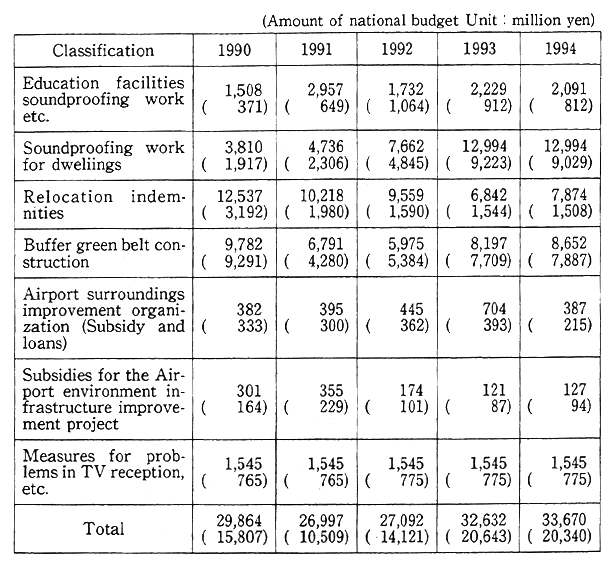
Notes:1. Data by Ministry of Transport
2. Figures in parenthesis are budget amounts concerning the Osaka Interna-tional Airport.
3. The expenditure for surveys are excluded.
As the result of the continuous promotion of measures for the surrounding areas, soundproofing construction was completed in most residences in 1985, achieving the targeted interior environment specified by the "Environmental Quality Standards for Aircraft Noise." In an effort to realize the harmonized growth of the airports and their sur-rounding areas, while utilizing the land from which residences or businesses have moved out, measures as follows have been taken:
1) The Ministry of Transportation and Osaka Prefecture have decided to create approximately 50 ha of green zone in the Osaka Prefecture side of the area around Osaka International Airport. The plan was approved in city planning in February 1987, and the approval for the project was given for a portion of the area in January, 1988, then the area was expanded in September 1994. In the Hyogo Prefecture side of the area, the creation of approximately 8.6 ha of green zone was also approved in city planning in March 1993, and the approval for the project was given in September 1993.
2) In the areas around Hakodate, Sendai, Niigata, Osaka Interna-tional, Nagoya, Matsuyama, Kochi, Fukuoka, and Miyazaki Airports, local public entities are providing support toward projects to develop base facilities for the surrounding environment such as parks, treed paths, etc., in the land from which residences or businesses have moved out.
For the area around New Tokyo International Airport, in order to realize the land utilization in harmony with the airport, the Basic Policies for Measures for Aircraft Noise was determined by the gover-nor of Chiba Prefecture in 1982, in conformity with the Special Measure-ment Law Concerning Airport Noise Countermeasures around Specified Aerodromes. Based on these policies, city planning concerning the Aircraft Noise Preventing Areas, etc. has been under way.
(4) Measures for aircraft noise around defense facilities
Concerning the aircraft noise problem in areas around airports of the Japan Self-Defense Forces, etc., it is very difficult to reduce the engine noise made by the aircraft because of their primary functions and purposes. The measures mainly taken to control the sources of noise and the operation system are the use of sound arresters, restrictions on flight methods, and so on. For the facilities of the U. S. forces stationed in Japan, requests for cooperation to take measures to control the sources of noise and operation methods have been made through the Japan-U. S. Joint Committee.
Table 7-4-6 Projects to Prevent Noise in Areas Around Defense Facilities
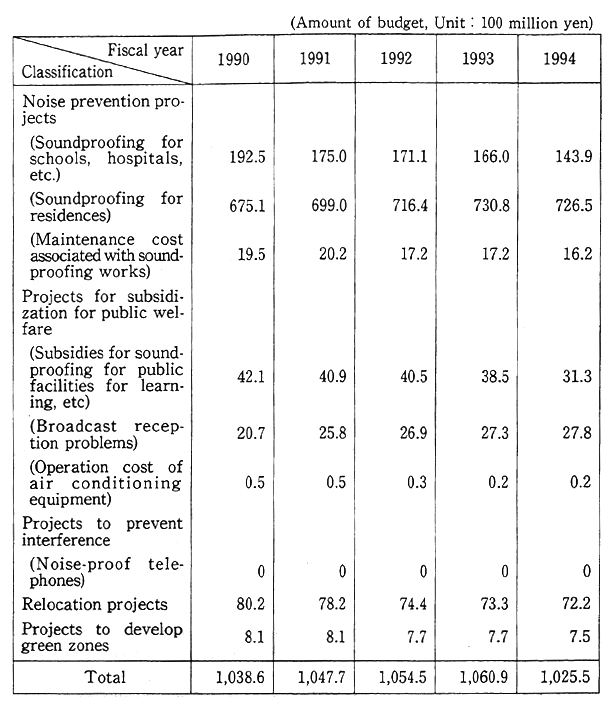
Notes:1. Data by Defense Agency.
2. Figures include small amount of expenses due to measures for noise caused other than by aircraft.
3. Total figure may not agree with actual figures due to rounding.
As measures to improve the areas around the defense facilities, various actions have been taken in accordance with the Law Concerning the Improvement of the Living Environment Around Defense Facilities. These measures include: financial aid for soundproofing construction for schools, hospitals, residences, etc.; compensation for moving of a building; purchase of land; development of green belts, etc.; financial aid for TV reception fees, and so on (Table 7-4-6).
As of the end of 1994, 25 areas around airports have been designated as Class I Area in accordance with the law, and financial aid for soundproofing works in the areas has been provided.
As described above, the measures for the areas surrounding airports have been promoted and enhanced in areas with defense facil-ities.
4. Measures for Noise and Vibration Caused by Shinkansen Trains
Ever since its opening of the Tokaido line in 1964, the Shinkansen railway system has made great progress as a mass-quantity high-speed transportation means. However, it has created noise and vibration problems in some areas along the lines which have become a major environmental problem.
In the Nagoya area, lawsuits demanding a ban of operations and compensation for damages were instituted because of the noise and vibration caused by the Tokaido Shinkansen trains in March, 1974. In April 1986, an amicable settlement was made by the agreement reached on the further promotion of measures to control the sources of noise and vibration.
(1) Establishment of the environmental quality standards and the progress of achievement
1) Environmental quality standards, etc.
The "Environmental Quality Standards Associated with the Noise of Shinkansen Trains" (established on 29 July 1975), which are the target of measures to control noise caused by the Shinkansen trains, specify allowable levels of noise for each area according to the classifi-cation of the area. The standards specify that the noise level in areas that are used chiefly for residential purposes to be 70 dB or less, and the level in areas that are used for commercial or industrial purposes to be 75 dB or less. The standards indicate that efforts to achieve or maintain these levels should be made.
The classification of areas is to be made by the governor of the prefecture or metropolis and it has been enforced in all 21 prefectures and metropolis in which the Shinkansen trains operate.
In order to help achieve the environmental quality standards smoothly, the Government obtained the Cabinet's approval on the "Outline of Measures Against the Noise of Shinkansen Trains," which specifies basic items such as measures for sources of noise and for problems, in March 1976. However, the Government had the Cabinet re-approve the "Promotion of Measures Against the Noise of Shinkan-sen Trains After the Reorganization of the Japanese National Railways" in March 1987. This was done so that the corporation taking over the operations of the Japanese National Railways, and the Japan Railway Construction Public Corp. can continuously promote the enforcement of the measures for noise problems specified in the outline, prior to the divestiture and privatization of the Japanese National Railways.
As for the vibration caused by Shinkansen trains, the "Measures for Vibration Caused by Shinkansen Trains Urgently Required to Preserve the Environment" was given to the Minister of Transportation by the Director General of the Environment Agency in March 1976.
2) Achievement status of the environmental quality standards
The environmental quality standards for noise were not satisfied in many areas along the Tokaido, Sanyo, Tohoku, and Joetsu Shinkan-sen lines even after the last year of the targeted time period for the achievement had past. Therefore, the Environment Agency requested the concerned parties for their cooperation in further promoting the measures to achieve the standards. The agency specified in this request that the level of noise in the areas where densely concentrated residen-tial areas exist continuously along the Tokaido/Sanyo Shinkansen line, and in the areas where residences are concentrated along the Tohoku/ Joetsu Shinkansen line (referred to as "Areas for 75 phons Measures" hereafter), to be 75 dB or less by the end of 1990. The investigation conducted in 1991 on the status of achievement revealed that the target level 75 dB was not achieved in some areas. The new target date of 1993 was set for those areas. The result of the investigation conducted in 1994 indicated that the target level of 75 dB was achieved in most areas, showing significant improvement (Table 7-4-7). The concerned parties have been requested to continuously strive for the achievement of the environmental quality standards in those areas that achieved the level of 75 dB. They are also requested to take necessary measures to promote the achievement of the goal in the areas which have been newly designated in 1991 as sections targeted for 75 dB.
Table 7-4-7 Status of Noise Levels in Areas with 75 Phons Measures
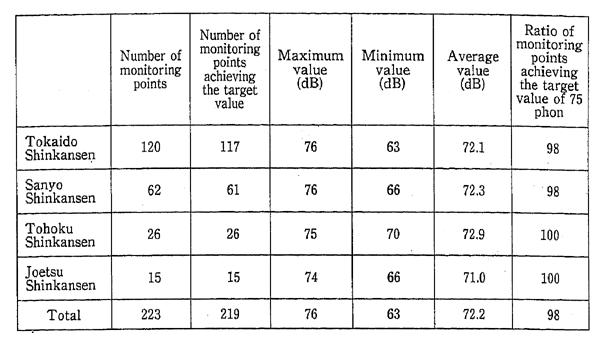
Notes:1. Number of monitoring points achieving the target value =number of monitoring points recording noise levels of 75 dB or less.
2. Ratio of monitoring points achieving the target value of 75 phon (%)=
(Number of monitoring points achieving the target value)/(Number of monitoring points) ×100
3. Data by Environment Agency.
As for vibration, an investigation on the achievement status of the index of 70 dB based on the advice of the Director General of the Environment Agency (March 1976) was conducted. The result of the investigation showed that, after the schedule change in November 1986, the targeted level was achieved in most areas except for those that are close to the track, on the Tokaido/ Sanyo Shinkansen line, and was achieved in all areas on the Tohoku and Joetsu Shinkansen lines.
(2) Enforcement of measures
In accordance with the notification issued by the Minister of Transportation, which is based on the "Outline of Measures Against the Noise of Shinkansen Trains" (approved by the Cabinet in March 1976) and the advice from the Director General of the Environment Agency (made in March 1976), East Japan Passenger Railway Company, Central Japan Passenger Railway Company, and West Japan Passenger Rail-way Company have enforced measures for sources of noise and vibra-tion, and measures for problems.
1) Measures for the sources of noise and vibration
Various comprehensive measures for the sources of noise and vibration have been conducted in the areas where densely concentrated residential areas exist continuously along the Tokaido/Sanyo Shinkan-sen line, and in the areas where residences are concentrated along the Tohoku/Joetsu Shinkansen line. These measures include installation of new-type soundproof walls, laying ballast, etc. The areas to which the measures are applied have been expanded since 1992. The areas where residences are concentrated along the Tokaido/Sanyo Shinkansen line, and similar areas are now applicable for the measures to be taken. For these areas, measures such as, increase of the size of soundproof walls, installation of improved soundproof walls, increase of the depth of rails, installation of pantograph covers, etc. are being enforced.
2) Measures for problems
Financial support for soundproofing has been provided to resi-dences in the areas of which the noise level exceeds 75 dB, and to schools, hospitals, etc. in the areas of which the noise level exceeds 70 dB. It has also been provided for buildings within the areas applicable to the measures upon request.
Financial support for vibration proofing and compensation for moving have been provided for the residences in the areas along the Tokaido/Sanyo Shinkansen line, of which the vibration level exceeds 70 dB. The same support has been provided for buildings within the areas applicable to the measures upon request.
(3) Research and development of technologies to prevent noise and vibration
In an effort to effectively enforce the measures for the sources of noise and for the problems, the research and development of technol-ogies which had been carried out by the Japanese National Railways until 1986, are now being carried out mainly by the Railway Technical Research Institute, the organization who has taken over the research and developmental operations from the Japanese National Railways after its reorganization.
In order to further reduce the noise caused by Shinkansen trains, studies on measures to control aerodynamic noise were continued in 1994.
(4) Noise and vibration problems caused by conventional trains
Complaints have been made concerning the noise and vibration caused by conventional trains. Especially since the occurrence of the noise and vibration problems associated with the opening of the Tsuga-ru Kaikyo line and the Seto Ohashi line, various measures have been enforced.
For each noise related problem, the Environment Agency is to take appropriate measures in cooperation with the parties concerned. However, for cases such as the opening of a new line, which could potentially create noise problems, the agency recognizes the necessity of setting standards in order to preserve the environment along the rail-way, and studies for this are under way.
Section5. Status of Noise Problem and Measures for Their Control
1. Status of Noise Problems
Since noise is a problem closely associated with our daily life, and has diverse sources, the number of complaints concerning noise accounts for the most among all pollution-related complaints made every year.
As for the sources of noise for which the complaints are made, the number of complaints made for noise caused by factories or workshops accounts for most, noise caused by construction works comes second, then comes the noise caused by late-night operations (Figure 7-5-1).
Although the overall number of complaints is decreasing, the noise generated in homes remains at the same level.
2. Measures for Noise
(1) Environmental Quality Standards for Noise
The "Environmental Quality Standards for Noise" were estab-lished on 25 May 1971 in conformity with the provisions under Section 9 of the Basic Law for Environmental Pollution Control. In this stan-dard system, areas are largely classified into two groups; general areas and areas facing roads. The standards are set for each group by type of area and by classification of time.
Fig. 7-5-1 Changes in Number of Complaints concerning Noise
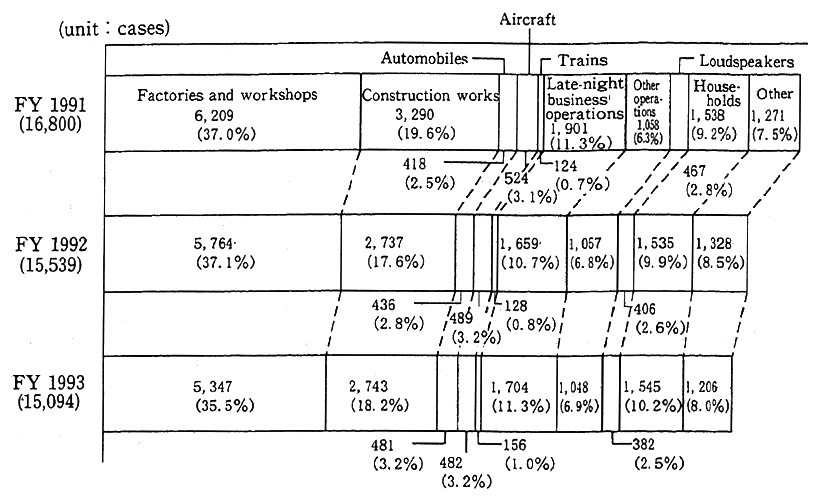
For the general areas, the standards are set in the range of 35 dB or less, which is set for the areas where quiet is especially required during the night, and 60 dB or less, which is set for the areas with considerable number of residences but also used for commercial and industrial purposes during the day, depending on the type of areas and classification of time. For the areas facing roads, the standards that are 5 -10 dB higher than those set for the general areas, have been set for each classification of areas depending on the number of lanes of the roads which the areas are facing. The classification of areas is to be made by the governor of each prefecture or metropolis. As of the end of 1993, the classification of areas has been completed for 605 cities, 872 towns, 103 villages, and 23 special wards in 47 prefectures.
(2) Controls under Noise Regulation Law
The Noise Regulation Law specifies that the governors of prefec-tures or mayors of administrative ordinance-designated cities are to designate areas of which the living environment should be preserved by controlling noise, and to control the noise which is affecting a consider-ably broad area, and that is caused by operations of factories or workshops, or construction works within the designated areas. The law also specifies that the Director General of the Environment Agency is to set the allowable limit of the noise level caused by automobiles, and that the governors of prefectures can demand measures for noise caused by road traffic to the Prefectural Public Safety Commissions.
As of the end of 1993, the designation of areas by the governors of prefectures or mayors of administrative ordinance-designated cities has been completed for 661 cities, 1,228 towns, 176 villages, and 23 special wards in 47 prefectures, which account for approximately 64% of the number of all cities, towns, wards, and villages.
1) Noise generated by factories or workshops
Regulations are applied to the factories and workshops which are located within the designated area, and are equipped with facilities specified by the government ordinance, such as metal processing machinery, etc. (referred to as "specified factories, etc." hereafter). The number of the specified factories, etc. within the designated areas is 202,554 as of the end of 1993.
The specified factories, etc. within the designated areas are bound to conform to the restriction standards. The governors of prefec-tures (or heads of municipalities applicable hereafter) can give the specified factories, etc. recommendation to change plans or recommen-dation to make improvements, or even issue orders to make improve-ments, when it is recognized that the living environment of the surround-ing areas is being marred by the noise which is generated from their facilities, and which is not satisfying the regulation standards. There were two cases where recommendation to make improvements was given in 1993. Besides these measures per the Noise Regulation Law, 901 cases of administrative guidance concerning noise controls, such as collecting of reports based on complaints, were carried out.
With the rapid progress of urbanization in the suburbs of large cities, new residential areas are forming around factories that have been in operation for many years. Recently, the number of noise problems in the suburban areas is increasing in this way. Survey of Countermeasures for Factory Noise in Rapidly Populated Areas was conducted to study measures for this type of noise problem. Another investigation was conducted to study the possible application of regulations to non-restricted facilities and construction works under the guidance of an expert group on countermeasures for noise generated by non-regulated facilities and construction works.
In the areas where residences and factories are intermixed and noise pollution already exists, measures such as installation of noise barriers, relocation of factories and workshops out of the areas, etc. are effective to control pollution. However, most of the factories or work-shops contributing to pollution are small-scale operations and usually are not able to relocate easily due to financial reasons. To help resolve this problem, the Small and Medium Enterprises Finance Corporation provides loans for relocation costs, and the Japan Environment Corpora-tion carries out construction of structures built collectively.
2) Noise generated by construction works
Restrictions are applied to construction works that are perfor-med within the designated areas, and that are specified by governmental ordinance, such as piling works, etc. There were 38,406 cases of notifica-tion concerning the execution of specified construction works in 1993.
The governors of prefectures can give the person in charge of the construction recommendation to make improvements, or orders to make improvements concerning methods of noise control, when it is recognized that the living environment of the surrounding areas is being marred by the noise which is generated by the construction works, and which is not satisfying the regulation standards. No recommendation or orders to make improvements were issued and 518 cases of administra-tive guidance concerning noise controls, such as collecting of reports based on complaints, were carried out in 1993.
(3) Neighborhood Noise
Recently, the ratio of the complaints concerning neighborhood noise, such as noise generated from late-night business operations, from loudspeakers, in homes, etc. has come to account for 40% of all com-plaints made, and measures are needed immediately.
In an effort to actively support the residents' activities to prevent noise created in the living environment, which is part of the movement to further improve the pleasant environmental amenities in urban areas, various enlightenment activities and a model project that adopted the soundscape method (the Sound Environment Model City Project) were carried out.
The Noise Regulation Law specifies that local public entities should take necessary measures to control noise created by late-night operation of restaurants or bars, noise generated by loudspeakers, and so on. As of the end of 1993, restrictions on noise caused by late-night operation were enforced in 41 prefectures and administrative ordinance-designated cities, and restrictions on noise created by loudspeakers were enforced in 44 prefectures, metropolis, and administrative ordinance-designated cities.
Section6. Status of Vibration Problem and Measures for Their Control
1. Status of Vibration Problem
Like noise, vibration is a problem that is closely connected to daily life among all pollution. The changes in the number of complaints made indicate that vibration related complaints are decreasing after 1988, the number of complaints made concerning vibration in 1993 was 1,083.
Among all complaints made, vibration caused by construction works was blamed most, vibration generated by operation of factories or workshops came second ; these two combined account for the majority of the total number of complaints.(Figure 7-6-1)
Fig. 7-6-1 Changes in Number of Complaints concerning Vibration
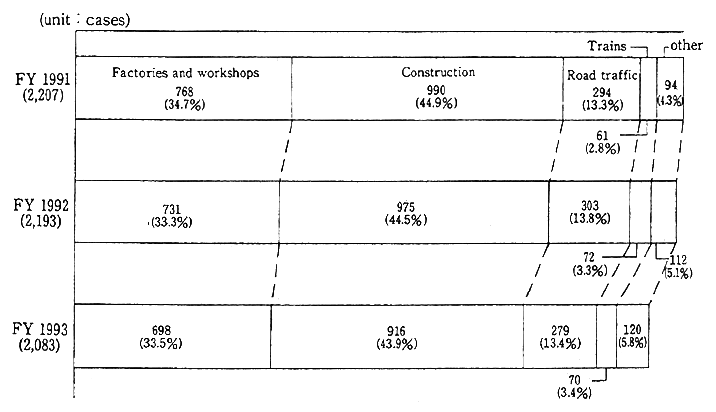
2. Measures for Vibration
(1) Controls under the Vibration Regulation Law
The Vibration Regulation Law specifies that the governors of prefectures or mayors of administrative ordinance-designated cities are to designate areas of which the living environment should be preserved by controlling vibration, and to regulate vibration which is affecting a considerably broad area, and that is caused by operations of factories or workshops, or construction works within the designated areas. The law also specifies that the governors of prefectures are to demand measures for vibration caused by road traffic from the Prefectural Public Safety Commissions.
As of the end of 1993, the designation of areas by the governors of prefectures or mayors of administrative ordinance-designated cities has been completed for 651 cities, 855 towns, 98 villages, and 23 special wards in 47 prefectures, which account for approximately 50% of the number of all cities, towns, wards, and villages.
1) Vibration generated by operation of factories and workshops
Regulations are applied to the factories and workshops which are located within the designated area, and are equipped with facilities specified by the government ordinance, such as metal processing machinery, etc. (referred to as "specified factories, etc." hereafter). The number of specified factories, etc. within the designated areas is 115,073 as of the end of 1993.
The specified factories, etc. within the designated areas are bound to conform to the regulation standards. The governors of prefec-tures (or heads of municipalities applicable hereafter) can give the specified factories, etc. recommendation to change plans or recommen-dation to make improvements, or issue orders to make improvements, when it is recognized that the living environment of the surrounding areas is being marred by the vibration which is generated from their facilities, and which is not satisfying the regulation standards. There was one case where recommendation to make improvements was given in 1993. Besides these measures per the Vibration Regulation Law, 167 cases of administrative guidance concerning controls of vibration, such, as collecting of reports based on complaints, were carried out.
In the areas where residences and factories are intermixed and vibration pollution already exists, measures such as installation of vibration control equipment, relocation of factories and workshops out of the areas, etc. are effective to control pollution. However, most of the factories or workshops contributing to pollution are small-scale opera-tions and usually are not able to take measures easily due to financial reasons. To help resolve this problem, the Smaller Business Finance Corporation provides loans for relocation costs, and the Japan Environ-ment Corporation carries out construction of structures built collective-ly.
2) Vibration generated by construction works
Regulations are applied to construction works that are performed within the designated areas, and that are specified by governmental ordinance, such as piling works, etc. There were 25,848 cases of notifica-tion concerning the execution of specified construction works in 1993.
The governors of prefectures can give the person in charge of the construction recommendation to make improvements, or orders to make improvements concerning methods of vibration control, when it is recognized that the living environment of the surrounding areas is being marred by the vibration which is generated by the construction, and which is not satisfying the regulation standards. No recommendation or orders to make improvements were issued and 237 cases of administra-tive guidance concerning vibration controls, such as collecting of reports based on complaints, were carried out in 1993.
To control vibration caused by construction works, development and advancing of low-vibration construction equipment and methods have been carried out.
(2) Measures for non-regulated sources of vibration
More than half of the complaints concerning vibration originate from facilities or construction works that are not applicable to the regulations. A fact-finding survey on vibration caused by non-regulated facilities was conducted.
(3) Measures for infrasound
There were 40 cases of complaints concerning infrasound. In-frasound is vibration caused by air with low frequency that is not audible to human ears, and it vibrates windows, doors, etc. and some-times affects the human body.
According to the studies conducted so far, there is no data that proves any effect given to the human body by the infrasound existing in the general environment.
Section7. Status of Offensive Odor and Measures for Their Control
1. Status of Offensive Odor
The number of complaints concerning offensive odor was drasti-cally decreasing until 1980, then the decrease rate slowed down and it eventually remained at the same level. The number of complaints concerning offensive odor was 9,972 in 1993. The ratio of complaints concerning the odor caused by animal farming and manufacturing industries shows a decreasing trend, while complaints originating from odor associated with urban life or daily living, such as odor caused by service industries, etc., are increasing (Figure 7-7-1).
Fig. 7-7-1 Changes in Number of Complaints concerning Offensive Odors
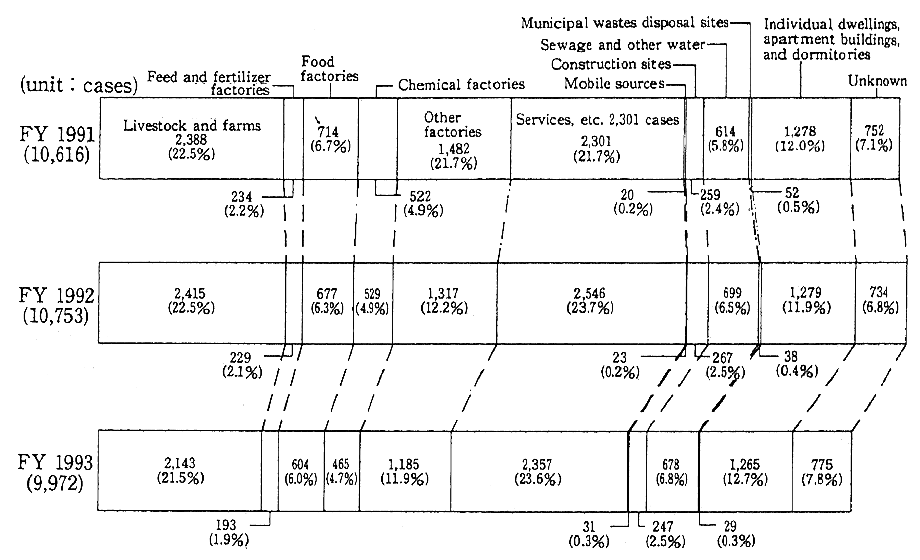
2. Measures for Offensive Odor
(1) Enforcement of the Offensive Odor Control Law
The Offensive Odor Control Law regulates the emission of offen-sive odor substances that are generated in the process of operation at a factory or workshop. The law specifies that the governors of prefec-tures or mayors of administrative ordinance-designated cities) are to designate the areas to be applicable to the regulations and to determine the regulatiory standards. As of the end of 1993, designation of areas have been completed in a total of 1,640 areas ; 602 cities, 893 towns, 122 villages, and 23 special wards in 47 prefectures (approximately 50% of all cities, towns, villages, and wards). The governors of prefectures can give the business operator recommendation to make improvements, or issue orders to make improvements in controlling the odor, when it is recognized that the living environment of the surrounding areas is being marred by the emission of an offensive odor substance which is generat-ed in the operation of the business, and which is not satisfying the regulatory standards. There were two cases of recommendation to make improvements in 1993 and no orders to make improvements were issued. Besides the measures based on the law, 4,384 cases of administra-tive guidance were carried out against businesses generating offensive odor within the designated areas
(2) Improvement of the Offensive Odor Control Law
Currently, regulatory standards are set for each offensive odor substance by the Offensive Odor Control Law. With these standards, the intensity of complex odors, which are created by addition and multipli-cation of odors and are more offensive to human senses than regular odors, can not be measured accurately. In addition, the number of complaints concerning offensive odors associated with daily life have been increasing recently.
To cope with this problem, the Environment Agency drafted the Law to Revise a Part of the Offensive Odor Control Law in considera-tion of the report titled "The Measures to be taken to Control Offensive Odor" submitted by the Central Environmental Council on 2 March 1995, and submitted the bill to the 132nd Diet. Major items suggested in the bill are:1) the adoption of an "Odor Index" method, in which human sense of smell is used to assess offensive odors, for the areas with complex odors which can not be measured accurately by current stan-dards that are set by each offelsive odor substance ; and 2) to provide stipulation concerning the duties of the people, local governments, and the Government in preventing offensive odors originating from daily living.
(3) Improvement of offensive odor prevention technologies
The Environment Agency collects information on effective odor preventing technologies and strives to diffuse the technologies nation-wide, so that persons in charge of odor problems at local governments can give appropriate guidance to businesses that are causing odor problems, according to the type of sources generating odors and the conditions of surrounding areas.
A preliminary investigation on the development of odor sensors, which can readily judge the conformity to the regulation standards, and can be used in guidance given to businesses, is under way.
(4) Studies on environmental standards for odor
Investigations are being conducted in order to establish goals for environmental preservation from the standpoint of odor prevention.
Chapter8. Current Condition and Measures for Water Pollution
Section1. Current Condition of Water Pollution and Its Causes
1. Actual Conditions
Measurements of Water Quality in Nationwide Public Water Areas were conducted in 1993 according to the new environmental quality standards of which the restrictions on substances that are harmful to human health, such as cadmium, etc., have been revised in March, 1993. According to the results of the measurements, there were 33 measurement points which recorded a level of pollution exceeding the environmental standard, out of 5,708 measurement points nationwide, indicating that the points at which the standard was not achieved was 0.58% of the total number of measurement points (Table 8-1-1).
As for conformity to the environmental standards concerning human health, because of the revision made to the standards, it is difficult to evaluate the status of conformity to the standards over the years. However, if calculated based on the conventional method to figure out the ratio of non-conformity (the ratio of the number of samples of which the level of pollution exceeded the standard, against the total number of samples examined), the ratio of non-conformity to the old environmental standard was 0.01%, which has improved steadily since 1971.
In 3,147 water areas (2,433 rivers, 128 lakes and reservoirs, and 586 sea areas) where classif cations of the environmental standards are applied by 1992 concerning items pertaining to preservation of the living environment, the environmental standards per BOD (or COD), a typical water quality index used to measure organic pollution level, were achieved in 76.5% of all water areas (75.2% in 1992) ; 23.5% of total water areas have not yet met the standard. The breakdown of areas achieving the standard by water area is rivers 77.3% (75.4% in 1992) lakes and reservoirs 46.1% (44.6 in 1992) ; and sea areas 79.5% (80.9% in 1992). The achievement ratio is especially low in closed water areas such as lakes and reservoirs, inner bays, inland seas, etc., and medium and small rivers in urban areas (Table 8-1-2, Figures 8-1-1 and 8-1-2).
Table 8-1-1 Rates of Measurement Points Exceeding Environmental Quality Standards Related to the Protection of Human Health
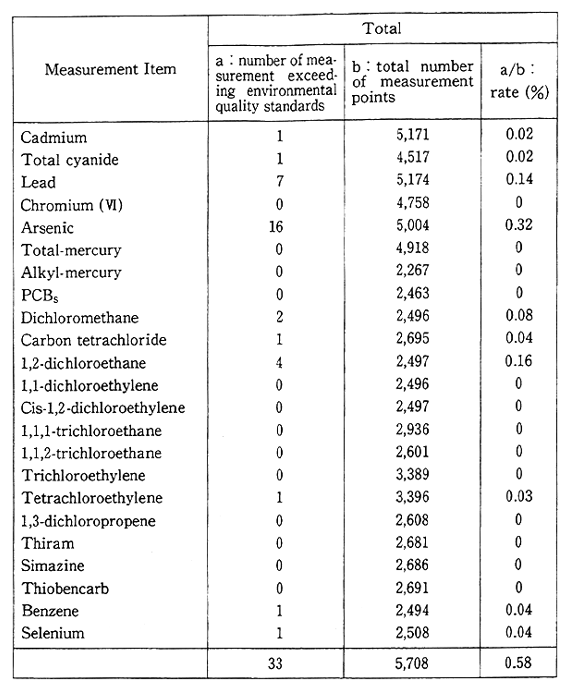
As regards other forms of water pollution, contamination of groundwater by substances such as trichloroethylene, etc.; contamina-tion by organic tin compounds in vast areas such as estuaries, inner bay areas, etc. ; the pollution of public waters by the outflow of hazardous substances due to accidental long-term turbid water due to dam con-struction (applicable to limited areas) ; acidification, caused by natural factors, of rivers, lakes and reservoirs in volcanic regions ; impact on the environment by thermal drainage from large power stations pose problems.
Table 8-1-2 Achievement State of Environmental Quality Standards (EQSs) (BOD or COD)
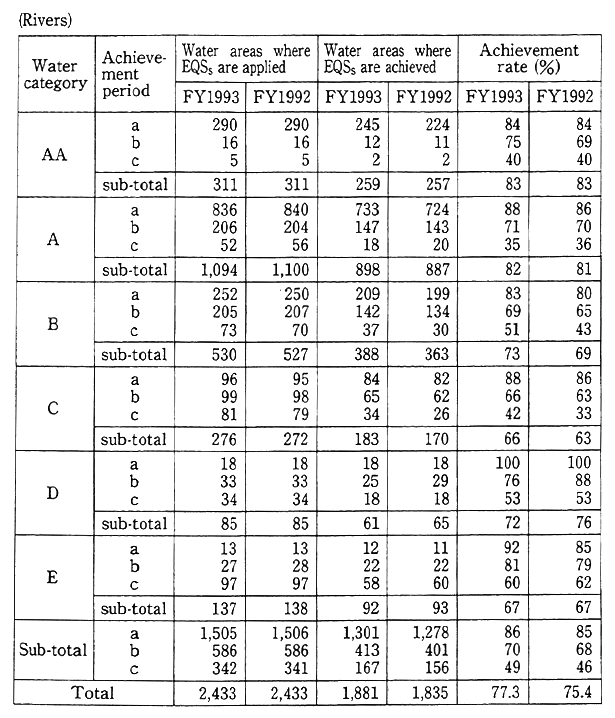
(Table 8-1-2 continued)
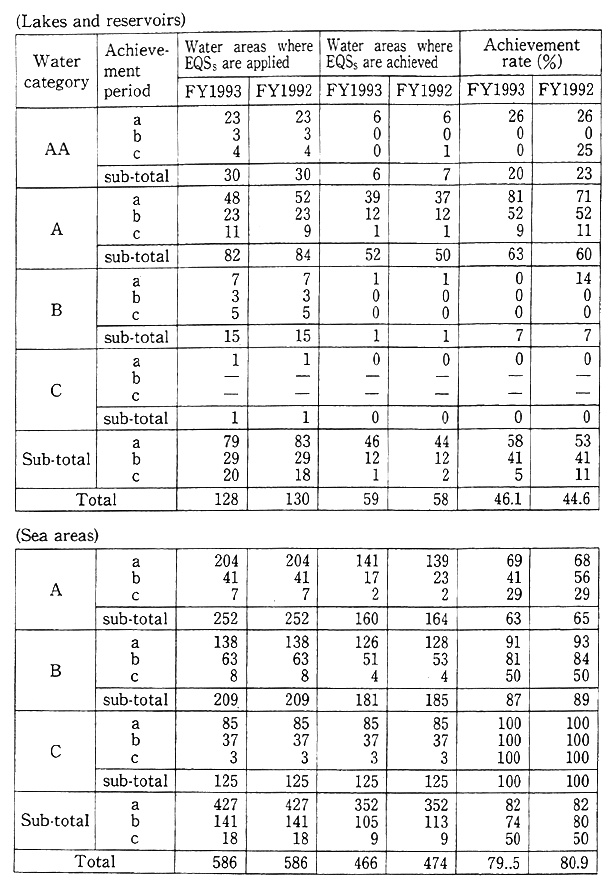
Note: Figures of the FY1993 survey the FY1992 survey are the results of the measurements conducted in the water areas to which water category were applied by FY1992 and FY1991 respectively.
Fig. 8-1-1 State of Water Pollution in Major Rivers (Fiscal year 1993)
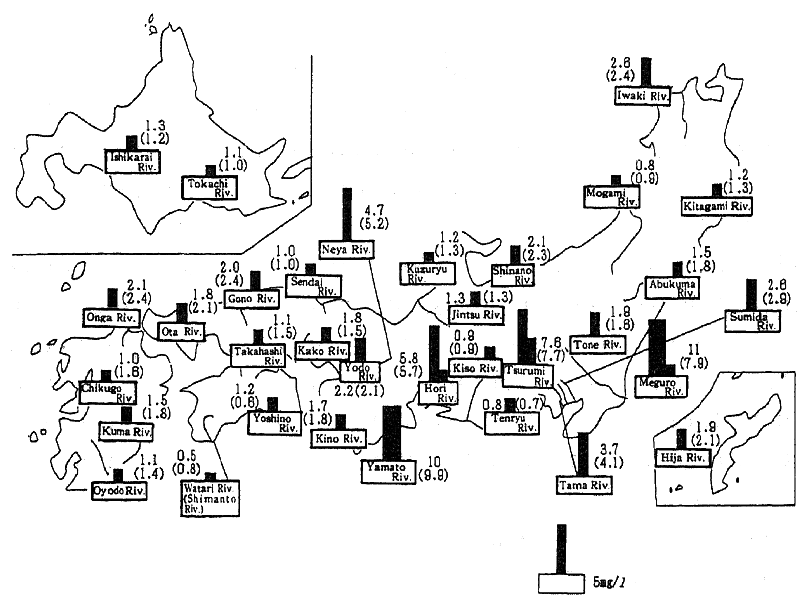
Notes: 1. Data of the Environment Agency
2. values of BOD are yearly average. Unit : mg/l
3. values in parentheses are surveyed in FY 1992
Fig. 8-1-2 State of Water Pollution in Major Lakes, Reservoirs, and Inner Bays (Fiscal year 1993)
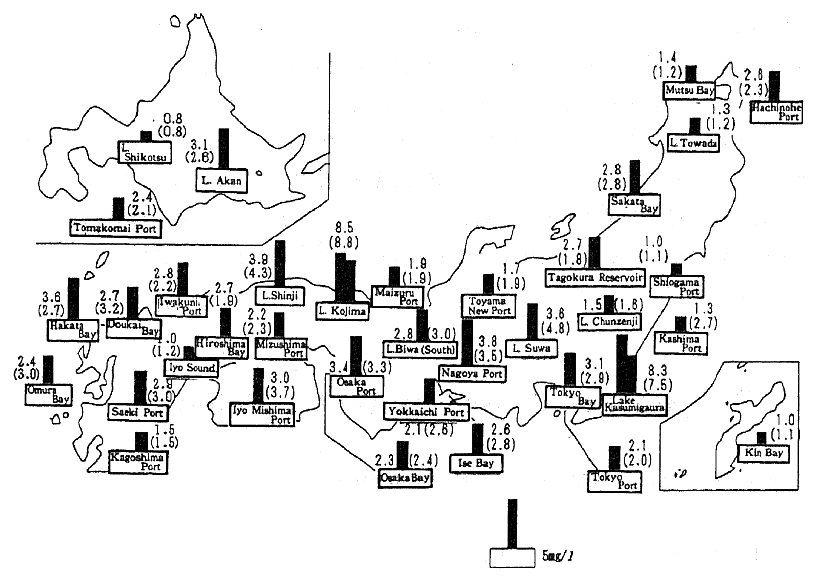
Notes: i. Data of the Environment Agency
2. values of BOD are yearly average. Unit : mg/l
3,. values in parentheses are surveyed in FY 1992
2. Causes
Tightened restrictions have proven effective to control pollution caused by effluent from factories and workshops. On the other hand, effluent associated with daily living such as cooking, laundry, bathing, etc., has not been controlled satisfactorily due to inadequate sewage systems, and so on.
The cause of pollution in closed water areas such as inner bay areas, inland seas, lakes and reservoirs, etc., is that due to physical features unique to closed water bodies, water often stagnates causing a favorable condition for contaminants to accumulate. The other cause of pollution in these areas is the socioeconomic factor; population and industries are concentrated in water front areas such as inner bays and inland seas.
In rivers in urban areas where population and industries concen-trate along them, and in lakes and reservoirs of which the surrounding areas are increasingly urbanized, such as Teganuma or Inbanunm, sewage systems can not catch up with the increase in population, and the pollution is encouraged by drain water, especially by household effluent.
As described above, recent water pollution is mainly caused by organic pollutants, and countermeasures against effluent from daily living are especially needed immediately. Besides this, water pollution is caused by unspecified sources i.e., contaminant effusing from urban areas, land creation sites, farming lands, etc., often washed out by rain, etc. Other causes include nutrient salts eluting from the bottom sedi-ment consisting of deposits which are the result of long-term water pollution. Conditions of these factors should be studied and appropriate measures must be taken.
Section2. Damages Caused by Water Pollution
1. Pollution of City Water Sources
Approximately 70% of the sources of city water are from surface flowing water such as rivers, and can be affected significantly by water pollution. Underground water that accounts for approximately 30% of the total sources of city water was considered to be of good quality, until pollution caused by substances such as trichlorethylene, etc. became actualized. In the fiscal year 1992, 79 city water systems were affected by water pollution in their sources.
Recently, the excess increase of algae due to eutrophication in reservoirs sometimes causes foul smell or taste in city water. In 1992, 106 city water systems were affected by foul smell and taste, disturbing approximately 15.8 million people.
To control water pollution occurring in the sources of city water systems, system operators are taking measures such as introduction of high-grade water purifying facilities. However, a contaminated water source is an enormous burden to the system operators from the stand-point of safety of city water, and can raise the cost of water treatment operations.
City water must be maintained at a safe and reliable quality for its users at all times, and the sources of water systems are desired to be maintained as pure as possible. Therefore, preservation of the quality of city water is becoming increasingly important.
2. Pollution of Industrial Water
Approximately 70% of the fresh water supply of industrial water depends on river water (approximately half of it is used for industrial tap water) such as surface water and infiltration water. Industrial water is used for many purposes such as for raw material, processing and washing of products, etc., and is sometimes affected by contamination of river water.
Industrial water is generally treated by chemical sedimentation Sometimes the disposition of sludge made from the contaminant of river water created through this treatment process raises a problem.
3. Agricultural Damages
With the advance of recent urbanization, there are occasionally cases where effluent from cities flows into agricultural water, causing substantial damages to agricultural production as well as the living environment in farming communities
Currently, the number of areas (5 ha or more) that are affected by polluted agricultural water is approximately 1,175 nationwide, total area of approximately 86,200 ha. The ratio of damages caused by the effluent from cities (including household effluent in agricultural commu-nities) is highest of all, and accounts for 84% of total damaged area (Table 8-2-1).
The result of the investigations conducted for two years since 1989 indicates that the number of areas damaged has increased by 10%, and the total area damaged has decreased by 2.9% as compared to the result from 1985. The total newly damaged area was approximately 24,000 ha, and 91% of the total area was damaged by effluent from cities.
Table 8-2-1 Number and Area of Districts where Affected Agricultural Water by Pollution Source
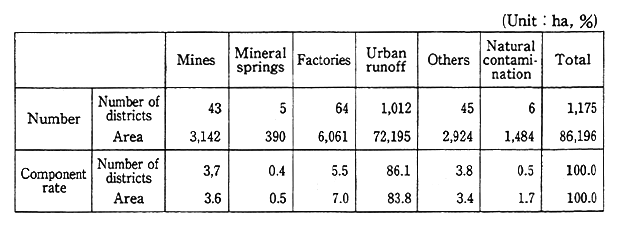
Note : Survey by Ministry of Agriculture, Forestry and Fisheries